Impact of Compensation and Rewards and Training and Development on Employee Engagement and Retention in UK Retail Industry
VerifiedAdded on 2023/06/12
|30
|6354
|71
AI Summary
This research project aims to analyze the importance of compensation and rewards and training and development for employees within an organization, types of compensation and rewards and training and development offered to workforce for retaining and developing employees within UK industry, impact of compensation and rewards on retention of employees and performance of business, and challenges faced by UK industry while selecting types of rewards and compensation within the workplace. The chosen industry is UK retail industry.
Contribute Materials
Your contribution can guide someone’s learning journey. Share your
documents today.
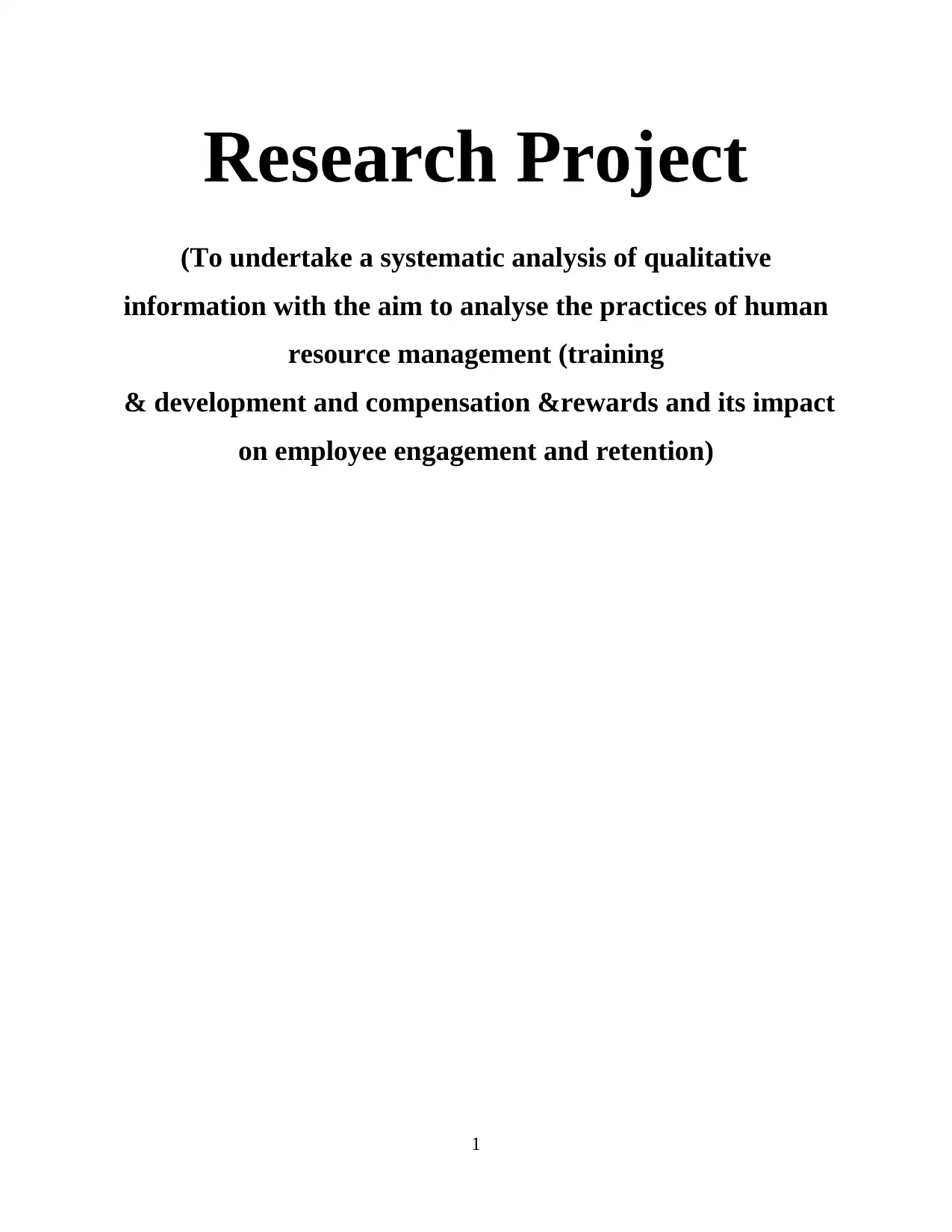
Research Project
(To undertake a systematic analysis of qualitative
information with the aim to analyse the practices of human
resource management (training
& development and compensation &rewards and its impact
on employee engagement and retention)
1
(To undertake a systematic analysis of qualitative
information with the aim to analyse the practices of human
resource management (training
& development and compensation &rewards and its impact
on employee engagement and retention)
1
Secure Best Marks with AI Grader
Need help grading? Try our AI Grader for instant feedback on your assignments.
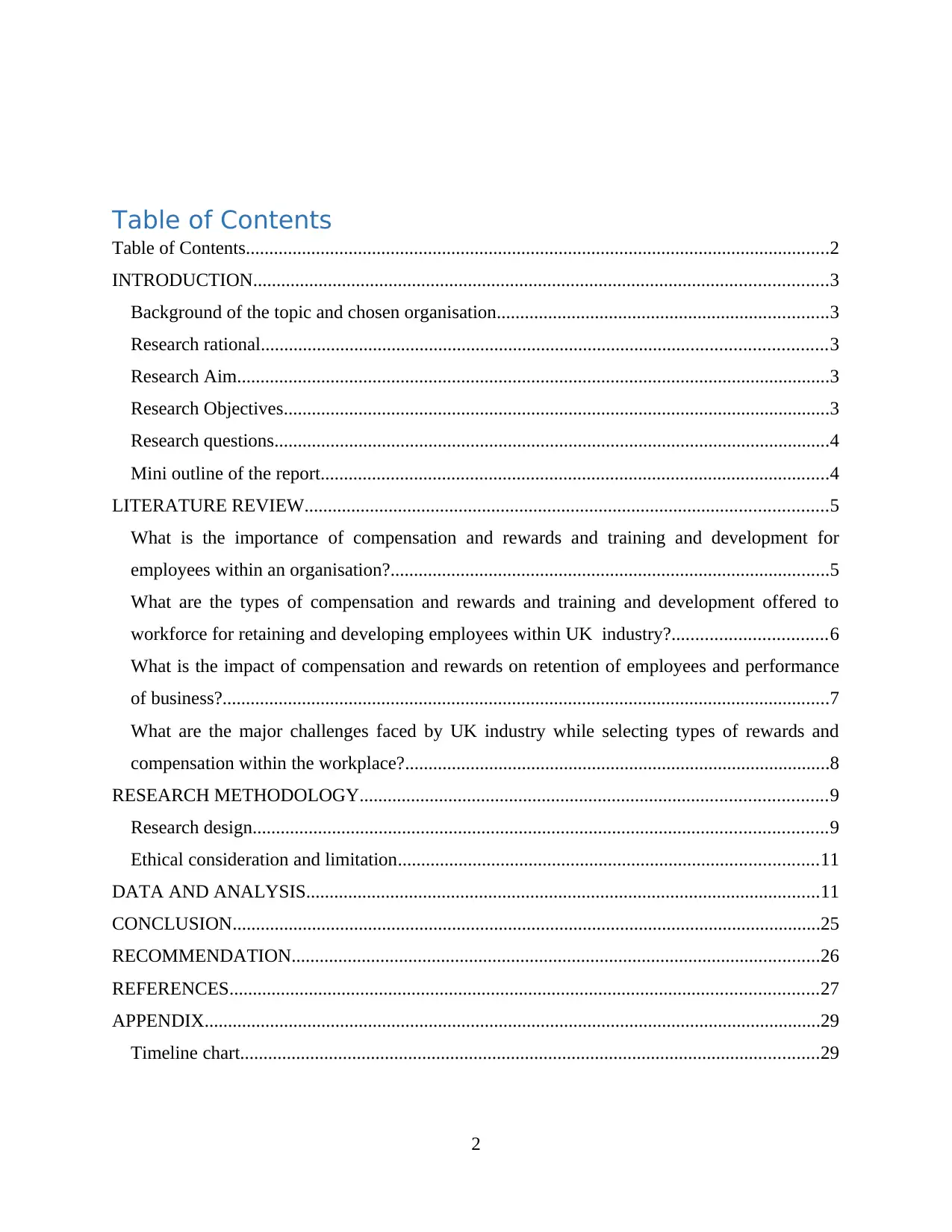
Table of Contents
Table of Contents.............................................................................................................................2
INTRODUCTION...........................................................................................................................3
Background of the topic and chosen organisation.......................................................................3
Research rational.........................................................................................................................3
Research Aim...............................................................................................................................3
Research Objectives.....................................................................................................................3
Research questions.......................................................................................................................4
Mini outline of the report.............................................................................................................4
LITERATURE REVIEW................................................................................................................5
What is the importance of compensation and rewards and training and development for
employees within an organisation?..............................................................................................5
What are the types of compensation and rewards and training and development offered to
workforce for retaining and developing employees within UK industry?.................................6
What is the impact of compensation and rewards on retention of employees and performance
of business?..................................................................................................................................7
What are the major challenges faced by UK industry while selecting types of rewards and
compensation within the workplace?...........................................................................................8
RESEARCH METHODOLOGY....................................................................................................9
Research design...........................................................................................................................9
Ethical consideration and limitation..........................................................................................11
DATA AND ANALYSIS..............................................................................................................11
CONCLUSION..............................................................................................................................25
RECOMMENDATION.................................................................................................................26
REFERENCES..............................................................................................................................27
APPENDIX....................................................................................................................................29
Timeline chart............................................................................................................................29
2
Table of Contents.............................................................................................................................2
INTRODUCTION...........................................................................................................................3
Background of the topic and chosen organisation.......................................................................3
Research rational.........................................................................................................................3
Research Aim...............................................................................................................................3
Research Objectives.....................................................................................................................3
Research questions.......................................................................................................................4
Mini outline of the report.............................................................................................................4
LITERATURE REVIEW................................................................................................................5
What is the importance of compensation and rewards and training and development for
employees within an organisation?..............................................................................................5
What are the types of compensation and rewards and training and development offered to
workforce for retaining and developing employees within UK industry?.................................6
What is the impact of compensation and rewards on retention of employees and performance
of business?..................................................................................................................................7
What are the major challenges faced by UK industry while selecting types of rewards and
compensation within the workplace?...........................................................................................8
RESEARCH METHODOLOGY....................................................................................................9
Research design...........................................................................................................................9
Ethical consideration and limitation..........................................................................................11
DATA AND ANALYSIS..............................................................................................................11
CONCLUSION..............................................................................................................................25
RECOMMENDATION.................................................................................................................26
REFERENCES..............................................................................................................................27
APPENDIX....................................................................................................................................29
Timeline chart............................................................................................................................29
2
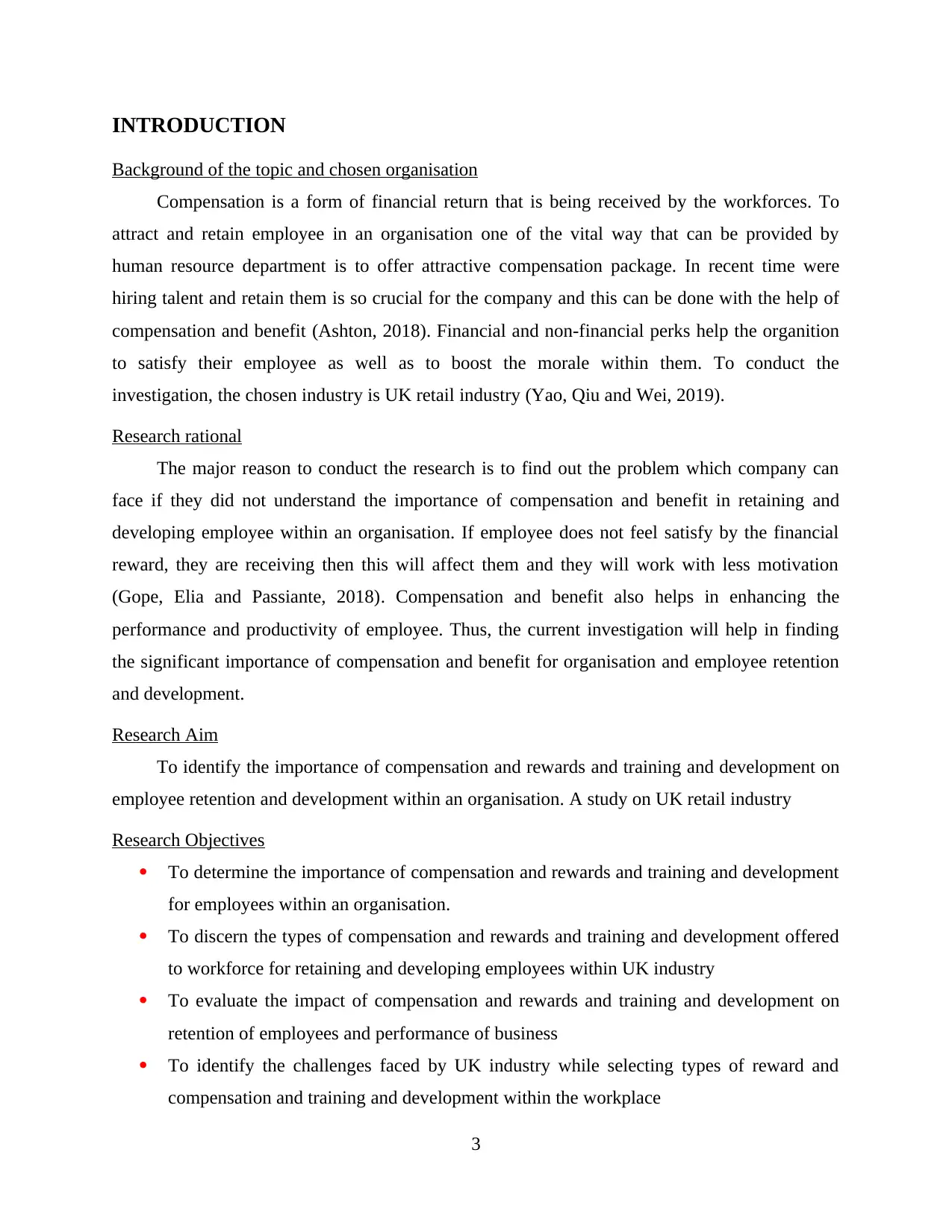
INTRODUCTION
Background of the topic and chosen organisation
Compensation is a form of financial return that is being received by the workforces. To
attract and retain employee in an organisation one of the vital way that can be provided by
human resource department is to offer attractive compensation package. In recent time were
hiring talent and retain them is so crucial for the company and this can be done with the help of
compensation and benefit (Ashton, 2018). Financial and non-financial perks help the organition
to satisfy their employee as well as to boost the morale within them. To conduct the
investigation, the chosen industry is UK retail industry (Yao, Qiu and Wei, 2019).
Research rational
The major reason to conduct the research is to find out the problem which company can
face if they did not understand the importance of compensation and benefit in retaining and
developing employee within an organisation. If employee does not feel satisfy by the financial
reward, they are receiving then this will affect them and they will work with less motivation
(Gope, Elia and Passiante, 2018). Compensation and benefit also helps in enhancing the
performance and productivity of employee. Thus, the current investigation will help in finding
the significant importance of compensation and benefit for organisation and employee retention
and development.
Research Aim
To identify the importance of compensation and rewards and training and development on
employee retention and development within an organisation. A study on UK retail industry
Research Objectives
To determine the importance of compensation and rewards and training and development
for employees within an organisation.
To discern the types of compensation and rewards and training and development offered
to workforce for retaining and developing employees within UK industry
To evaluate the impact of compensation and rewards and training and development on
retention of employees and performance of business
To identify the challenges faced by UK industry while selecting types of reward and
compensation and training and development within the workplace
3
Background of the topic and chosen organisation
Compensation is a form of financial return that is being received by the workforces. To
attract and retain employee in an organisation one of the vital way that can be provided by
human resource department is to offer attractive compensation package. In recent time were
hiring talent and retain them is so crucial for the company and this can be done with the help of
compensation and benefit (Ashton, 2018). Financial and non-financial perks help the organition
to satisfy their employee as well as to boost the morale within them. To conduct the
investigation, the chosen industry is UK retail industry (Yao, Qiu and Wei, 2019).
Research rational
The major reason to conduct the research is to find out the problem which company can
face if they did not understand the importance of compensation and benefit in retaining and
developing employee within an organisation. If employee does not feel satisfy by the financial
reward, they are receiving then this will affect them and they will work with less motivation
(Gope, Elia and Passiante, 2018). Compensation and benefit also helps in enhancing the
performance and productivity of employee. Thus, the current investigation will help in finding
the significant importance of compensation and benefit for organisation and employee retention
and development.
Research Aim
To identify the importance of compensation and rewards and training and development on
employee retention and development within an organisation. A study on UK retail industry
Research Objectives
To determine the importance of compensation and rewards and training and development
for employees within an organisation.
To discern the types of compensation and rewards and training and development offered
to workforce for retaining and developing employees within UK industry
To evaluate the impact of compensation and rewards and training and development on
retention of employees and performance of business
To identify the challenges faced by UK industry while selecting types of reward and
compensation and training and development within the workplace
3
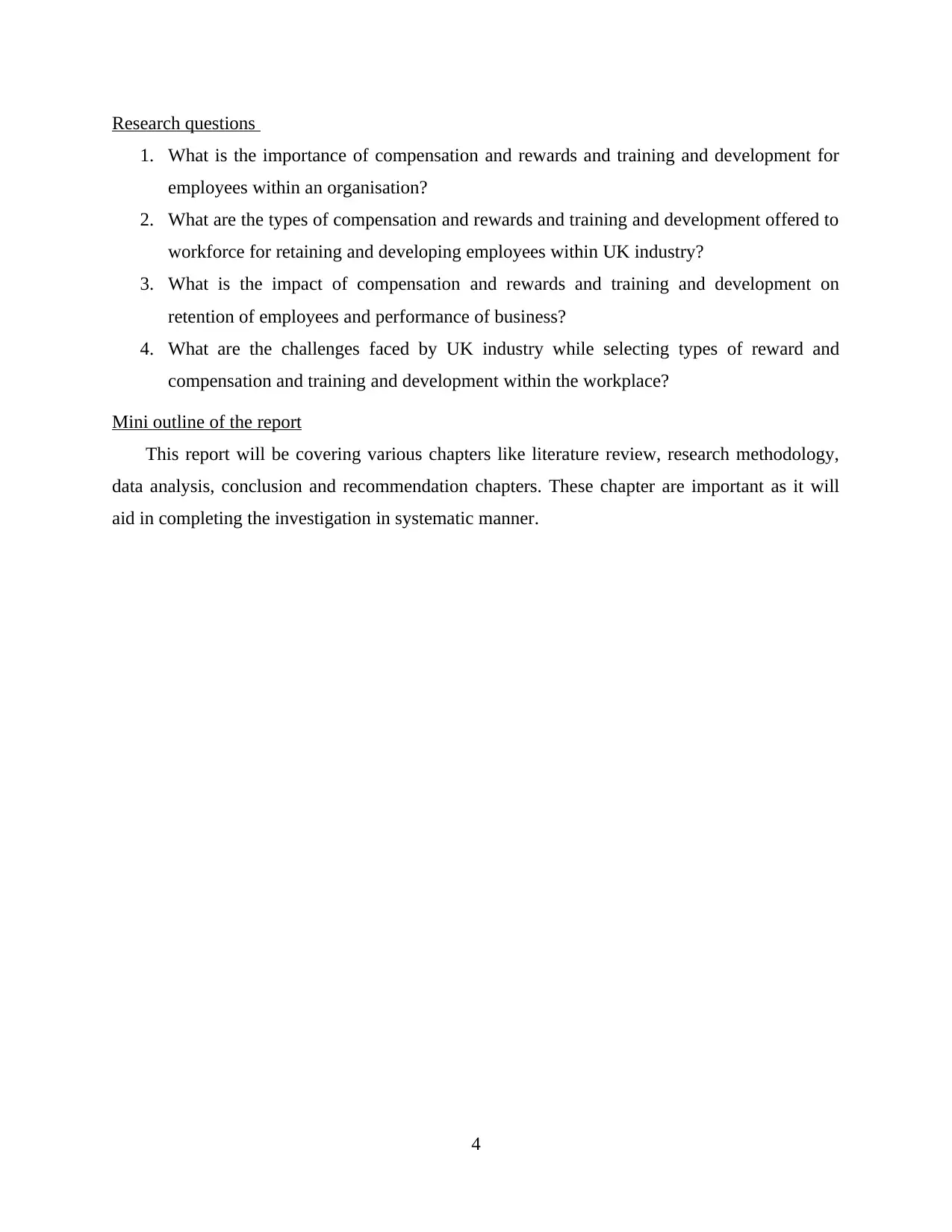
Research questions
1. What is the importance of compensation and rewards and training and development for
employees within an organisation?
2. What are the types of compensation and rewards and training and development offered to
workforce for retaining and developing employees within UK industry?
3. What is the impact of compensation and rewards and training and development on
retention of employees and performance of business?
4. What are the challenges faced by UK industry while selecting types of reward and
compensation and training and development within the workplace?
Mini outline of the report
This report will be covering various chapters like literature review, research methodology,
data analysis, conclusion and recommendation chapters. These chapter are important as it will
aid in completing the investigation in systematic manner.
4
1. What is the importance of compensation and rewards and training and development for
employees within an organisation?
2. What are the types of compensation and rewards and training and development offered to
workforce for retaining and developing employees within UK industry?
3. What is the impact of compensation and rewards and training and development on
retention of employees and performance of business?
4. What are the challenges faced by UK industry while selecting types of reward and
compensation and training and development within the workplace?
Mini outline of the report
This report will be covering various chapters like literature review, research methodology,
data analysis, conclusion and recommendation chapters. These chapter are important as it will
aid in completing the investigation in systematic manner.
4
Secure Best Marks with AI Grader
Need help grading? Try our AI Grader for instant feedback on your assignments.
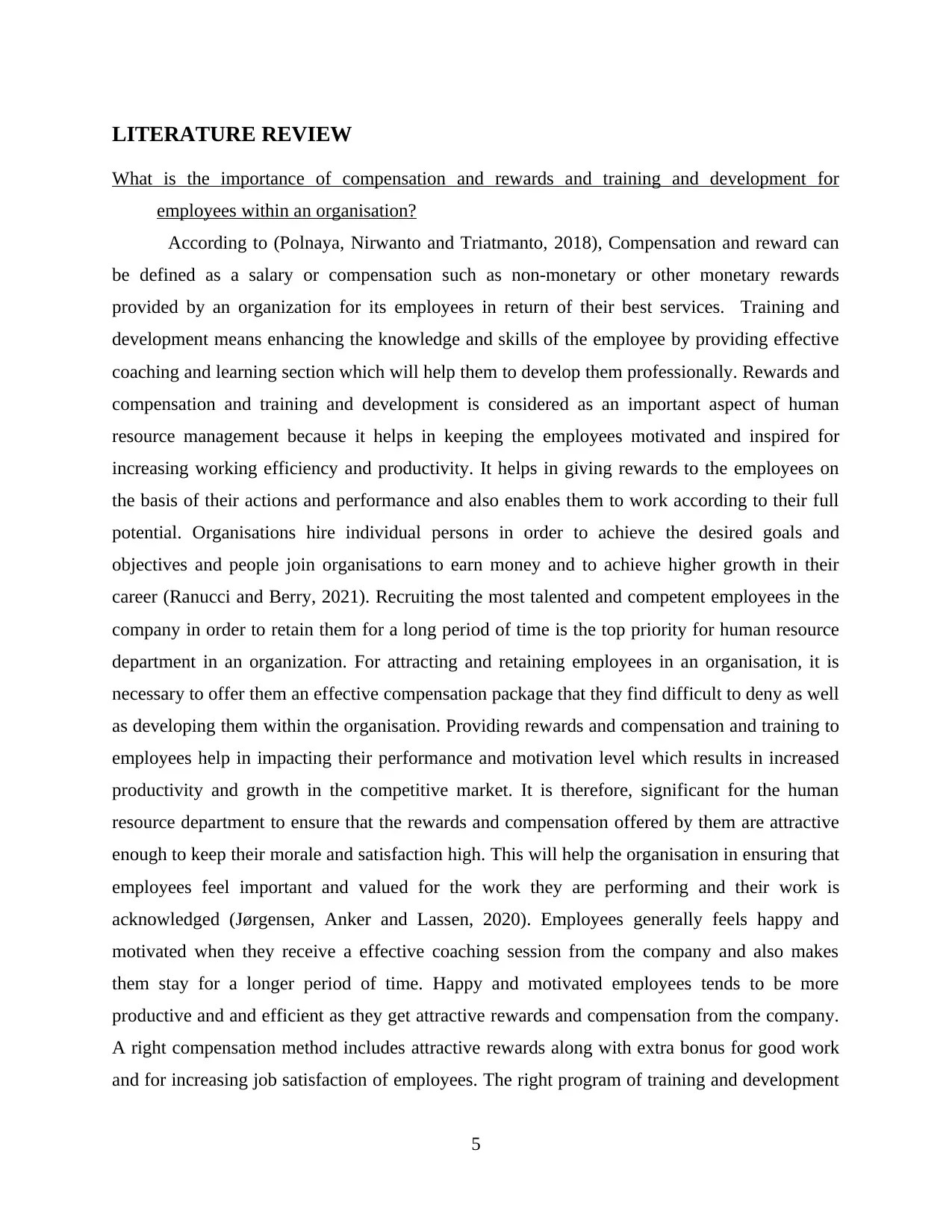
LITERATURE REVIEW
What is the importance of compensation and rewards and training and development for
employees within an organisation?
According to (Polnaya, Nirwanto and Triatmanto, 2018), Compensation and reward can
be defined as a salary or compensation such as non-monetary or other monetary rewards
provided by an organization for its employees in return of their best services. Training and
development means enhancing the knowledge and skills of the employee by providing effective
coaching and learning section which will help them to develop them professionally. Rewards and
compensation and training and development is considered as an important aspect of human
resource management because it helps in keeping the employees motivated and inspired for
increasing working efficiency and productivity. It helps in giving rewards to the employees on
the basis of their actions and performance and also enables them to work according to their full
potential. Organisations hire individual persons in order to achieve the desired goals and
objectives and people join organisations to earn money and to achieve higher growth in their
career (Ranucci and Berry, 2021). Recruiting the most talented and competent employees in the
company in order to retain them for a long period of time is the top priority for human resource
department in an organization. For attracting and retaining employees in an organisation, it is
necessary to offer them an effective compensation package that they find difficult to deny as well
as developing them within the organisation. Providing rewards and compensation and training to
employees help in impacting their performance and motivation level which results in increased
productivity and growth in the competitive market. It is therefore, significant for the human
resource department to ensure that the rewards and compensation offered by them are attractive
enough to keep their morale and satisfaction high. This will help the organisation in ensuring that
employees feel important and valued for the work they are performing and their work is
acknowledged (Jørgensen, Anker and Lassen, 2020). Employees generally feels happy and
motivated when they receive a effective coaching session from the company and also makes
them stay for a longer period of time. Happy and motivated employees tends to be more
productive and and efficient as they get attractive rewards and compensation from the company.
A right compensation method includes attractive rewards along with extra bonus for good work
and for increasing job satisfaction of employees. The right program of training and development
5
What is the importance of compensation and rewards and training and development for
employees within an organisation?
According to (Polnaya, Nirwanto and Triatmanto, 2018), Compensation and reward can
be defined as a salary or compensation such as non-monetary or other monetary rewards
provided by an organization for its employees in return of their best services. Training and
development means enhancing the knowledge and skills of the employee by providing effective
coaching and learning section which will help them to develop them professionally. Rewards and
compensation and training and development is considered as an important aspect of human
resource management because it helps in keeping the employees motivated and inspired for
increasing working efficiency and productivity. It helps in giving rewards to the employees on
the basis of their actions and performance and also enables them to work according to their full
potential. Organisations hire individual persons in order to achieve the desired goals and
objectives and people join organisations to earn money and to achieve higher growth in their
career (Ranucci and Berry, 2021). Recruiting the most talented and competent employees in the
company in order to retain them for a long period of time is the top priority for human resource
department in an organization. For attracting and retaining employees in an organisation, it is
necessary to offer them an effective compensation package that they find difficult to deny as well
as developing them within the organisation. Providing rewards and compensation and training to
employees help in impacting their performance and motivation level which results in increased
productivity and growth in the competitive market. It is therefore, significant for the human
resource department to ensure that the rewards and compensation offered by them are attractive
enough to keep their morale and satisfaction high. This will help the organisation in ensuring that
employees feel important and valued for the work they are performing and their work is
acknowledged (Jørgensen, Anker and Lassen, 2020). Employees generally feels happy and
motivated when they receive a effective coaching session from the company and also makes
them stay for a longer period of time. Happy and motivated employees tends to be more
productive and and efficient as they get attractive rewards and compensation from the company.
A right compensation method includes attractive rewards along with extra bonus for good work
and for increasing job satisfaction of employees. The right program of training and development
5
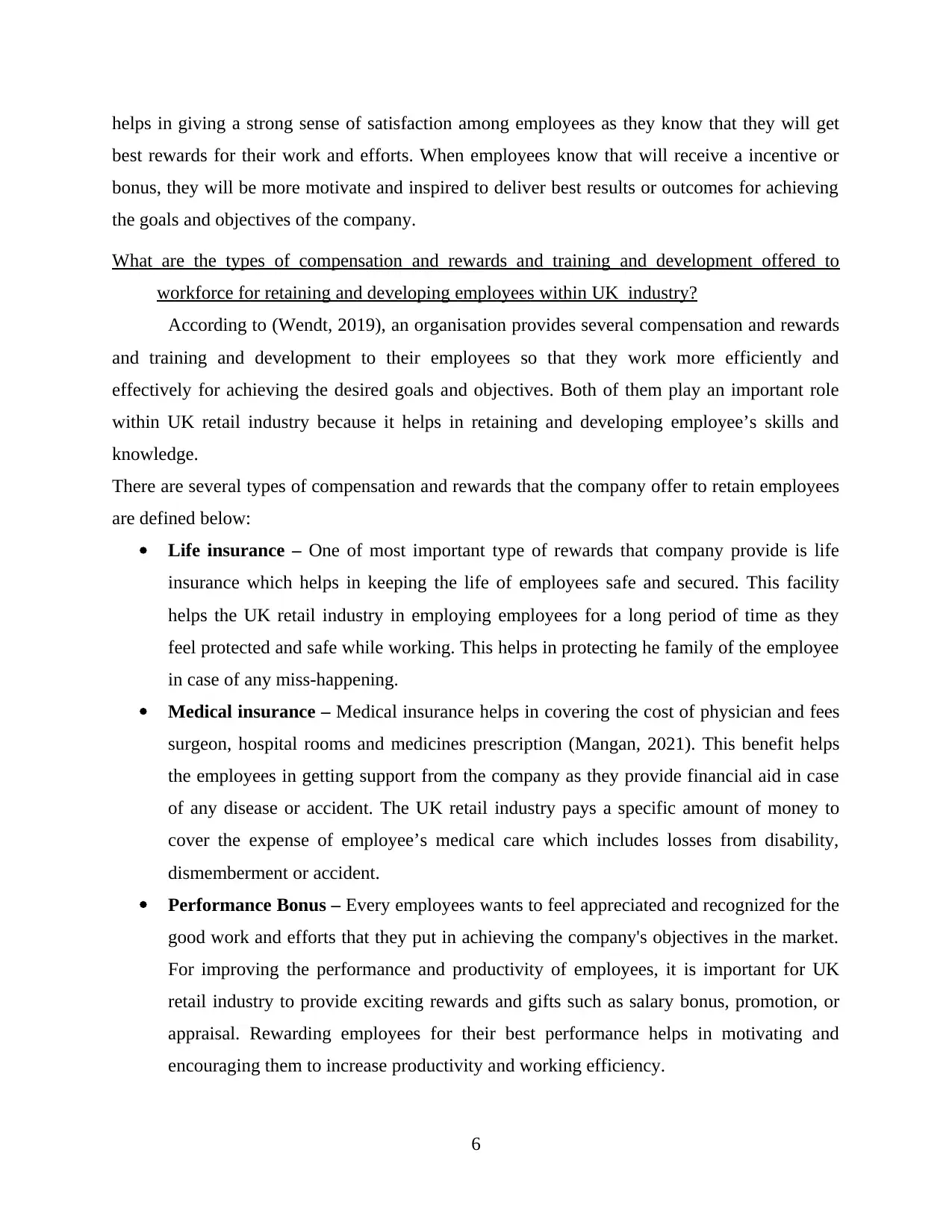
helps in giving a strong sense of satisfaction among employees as they know that they will get
best rewards for their work and efforts. When employees know that will receive a incentive or
bonus, they will be more motivate and inspired to deliver best results or outcomes for achieving
the goals and objectives of the company.
What are the types of compensation and rewards and training and development offered to
workforce for retaining and developing employees within UK industry?
According to (Wendt, 2019), an organisation provides several compensation and rewards
and training and development to their employees so that they work more efficiently and
effectively for achieving the desired goals and objectives. Both of them play an important role
within UK retail industry because it helps in retaining and developing employee’s skills and
knowledge.
There are several types of compensation and rewards that the company offer to retain employees
are defined below:
Life insurance – One of most important type of rewards that company provide is life
insurance which helps in keeping the life of employees safe and secured. This facility
helps the UK retail industry in employing employees for a long period of time as they
feel protected and safe while working. This helps in protecting he family of the employee
in case of any miss-happening.
Medical insurance – Medical insurance helps in covering the cost of physician and fees
surgeon, hospital rooms and medicines prescription (Mangan, 2021). This benefit helps
the employees in getting support from the company as they provide financial aid in case
of any disease or accident. The UK retail industry pays a specific amount of money to
cover the expense of employee’s medical care which includes losses from disability,
dismemberment or accident.
Performance Bonus – Every employees wants to feel appreciated and recognized for the
good work and efforts that they put in achieving the company's objectives in the market.
For improving the performance and productivity of employees, it is important for UK
retail industry to provide exciting rewards and gifts such as salary bonus, promotion, or
appraisal. Rewarding employees for their best performance helps in motivating and
encouraging them to increase productivity and working efficiency.
6
best rewards for their work and efforts. When employees know that will receive a incentive or
bonus, they will be more motivate and inspired to deliver best results or outcomes for achieving
the goals and objectives of the company.
What are the types of compensation and rewards and training and development offered to
workforce for retaining and developing employees within UK industry?
According to (Wendt, 2019), an organisation provides several compensation and rewards
and training and development to their employees so that they work more efficiently and
effectively for achieving the desired goals and objectives. Both of them play an important role
within UK retail industry because it helps in retaining and developing employee’s skills and
knowledge.
There are several types of compensation and rewards that the company offer to retain employees
are defined below:
Life insurance – One of most important type of rewards that company provide is life
insurance which helps in keeping the life of employees safe and secured. This facility
helps the UK retail industry in employing employees for a long period of time as they
feel protected and safe while working. This helps in protecting he family of the employee
in case of any miss-happening.
Medical insurance – Medical insurance helps in covering the cost of physician and fees
surgeon, hospital rooms and medicines prescription (Mangan, 2021). This benefit helps
the employees in getting support from the company as they provide financial aid in case
of any disease or accident. The UK retail industry pays a specific amount of money to
cover the expense of employee’s medical care which includes losses from disability,
dismemberment or accident.
Performance Bonus – Every employees wants to feel appreciated and recognized for the
good work and efforts that they put in achieving the company's objectives in the market.
For improving the performance and productivity of employees, it is important for UK
retail industry to provide exciting rewards and gifts such as salary bonus, promotion, or
appraisal. Rewarding employees for their best performance helps in motivating and
encouraging them to increase productivity and working efficiency.
6
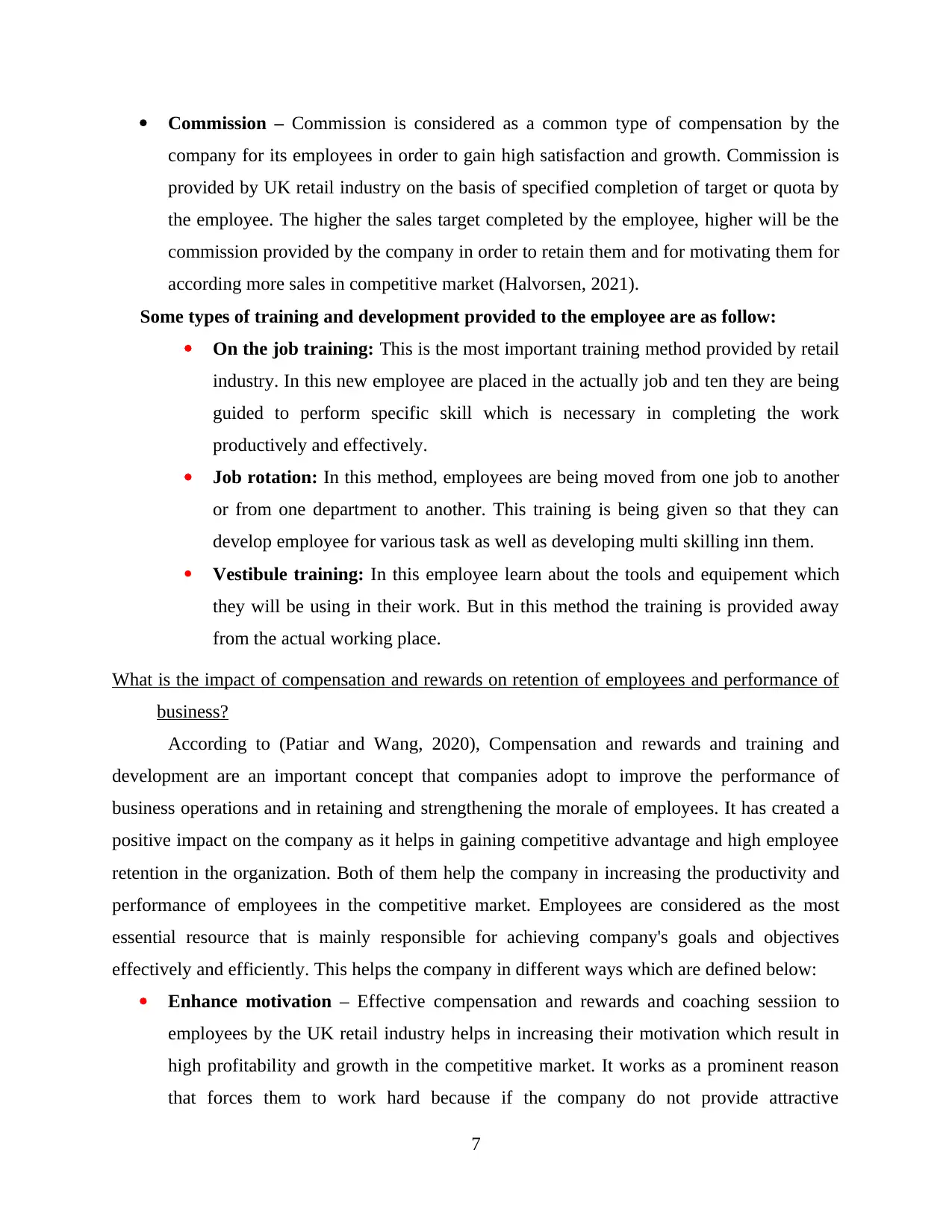
Commission – Commission is considered as a common type of compensation by the
company for its employees in order to gain high satisfaction and growth. Commission is
provided by UK retail industry on the basis of specified completion of target or quota by
the employee. The higher the sales target completed by the employee, higher will be the
commission provided by the company in order to retain them and for motivating them for
according more sales in competitive market (Halvorsen, 2021).
Some types of training and development provided to the employee are as follow:
On the job training: This is the most important training method provided by retail
industry. In this new employee are placed in the actually job and ten they are being
guided to perform specific skill which is necessary in completing the work
productively and effectively.
Job rotation: In this method, employees are being moved from one job to another
or from one department to another. This training is being given so that they can
develop employee for various task as well as developing multi skilling inn them.
Vestibule training: In this employee learn about the tools and equipement which
they will be using in their work. But in this method the training is provided away
from the actual working place.
What is the impact of compensation and rewards on retention of employees and performance of
business?
According to (Patiar and Wang, 2020), Compensation and rewards and training and
development are an important concept that companies adopt to improve the performance of
business operations and in retaining and strengthening the morale of employees. It has created a
positive impact on the company as it helps in gaining competitive advantage and high employee
retention in the organization. Both of them help the company in increasing the productivity and
performance of employees in the competitive market. Employees are considered as the most
essential resource that is mainly responsible for achieving company's goals and objectives
effectively and efficiently. This helps the company in different ways which are defined below:
Enhance motivation – Effective compensation and rewards and coaching sessiion to
employees by the UK retail industry helps in increasing their motivation which result in
high profitability and growth in the competitive market. It works as a prominent reason
that forces them to work hard because if the company do not provide attractive
7
company for its employees in order to gain high satisfaction and growth. Commission is
provided by UK retail industry on the basis of specified completion of target or quota by
the employee. The higher the sales target completed by the employee, higher will be the
commission provided by the company in order to retain them and for motivating them for
according more sales in competitive market (Halvorsen, 2021).
Some types of training and development provided to the employee are as follow:
On the job training: This is the most important training method provided by retail
industry. In this new employee are placed in the actually job and ten they are being
guided to perform specific skill which is necessary in completing the work
productively and effectively.
Job rotation: In this method, employees are being moved from one job to another
or from one department to another. This training is being given so that they can
develop employee for various task as well as developing multi skilling inn them.
Vestibule training: In this employee learn about the tools and equipement which
they will be using in their work. But in this method the training is provided away
from the actual working place.
What is the impact of compensation and rewards on retention of employees and performance of
business?
According to (Patiar and Wang, 2020), Compensation and rewards and training and
development are an important concept that companies adopt to improve the performance of
business operations and in retaining and strengthening the morale of employees. It has created a
positive impact on the company as it helps in gaining competitive advantage and high employee
retention in the organization. Both of them help the company in increasing the productivity and
performance of employees in the competitive market. Employees are considered as the most
essential resource that is mainly responsible for achieving company's goals and objectives
effectively and efficiently. This helps the company in different ways which are defined below:
Enhance motivation – Effective compensation and rewards and coaching sessiion to
employees by the UK retail industry helps in increasing their motivation which result in
high profitability and growth in the competitive market. It works as a prominent reason
that forces them to work hard because if the company do not provide attractive
7
Paraphrase This Document
Need a fresh take? Get an instant paraphrase of this document with our AI Paraphraser
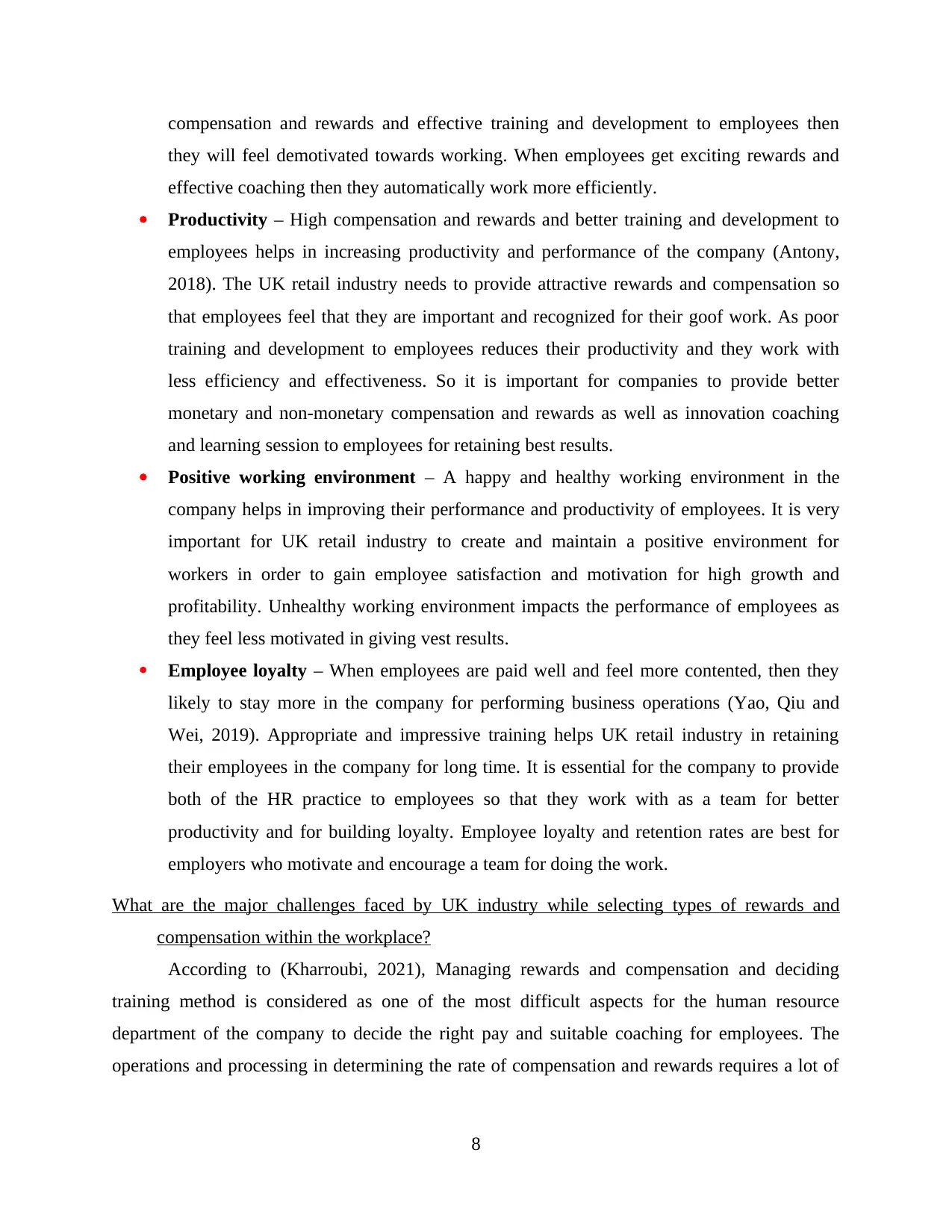
compensation and rewards and effective training and development to employees then
they will feel demotivated towards working. When employees get exciting rewards and
effective coaching then they automatically work more efficiently.
Productivity – High compensation and rewards and better training and development to
employees helps in increasing productivity and performance of the company (Antony,
2018). The UK retail industry needs to provide attractive rewards and compensation so
that employees feel that they are important and recognized for their goof work. As poor
training and development to employees reduces their productivity and they work with
less efficiency and effectiveness. So it is important for companies to provide better
monetary and non-monetary compensation and rewards as well as innovation coaching
and learning session to employees for retaining best results.
Positive working environment – A happy and healthy working environment in the
company helps in improving their performance and productivity of employees. It is very
important for UK retail industry to create and maintain a positive environment for
workers in order to gain employee satisfaction and motivation for high growth and
profitability. Unhealthy working environment impacts the performance of employees as
they feel less motivated in giving vest results.
Employee loyalty – When employees are paid well and feel more contented, then they
likely to stay more in the company for performing business operations (Yao, Qiu and
Wei, 2019). Appropriate and impressive training helps UK retail industry in retaining
their employees in the company for long time. It is essential for the company to provide
both of the HR practice to employees so that they work with as a team for better
productivity and for building loyalty. Employee loyalty and retention rates are best for
employers who motivate and encourage a team for doing the work.
What are the major challenges faced by UK industry while selecting types of rewards and
compensation within the workplace?
According to (Kharroubi, 2021), Managing rewards and compensation and deciding
training method is considered as one of the most difficult aspects for the human resource
department of the company to decide the right pay and suitable coaching for employees. The
operations and processing in determining the rate of compensation and rewards requires a lot of
8
they will feel demotivated towards working. When employees get exciting rewards and
effective coaching then they automatically work more efficiently.
Productivity – High compensation and rewards and better training and development to
employees helps in increasing productivity and performance of the company (Antony,
2018). The UK retail industry needs to provide attractive rewards and compensation so
that employees feel that they are important and recognized for their goof work. As poor
training and development to employees reduces their productivity and they work with
less efficiency and effectiveness. So it is important for companies to provide better
monetary and non-monetary compensation and rewards as well as innovation coaching
and learning session to employees for retaining best results.
Positive working environment – A happy and healthy working environment in the
company helps in improving their performance and productivity of employees. It is very
important for UK retail industry to create and maintain a positive environment for
workers in order to gain employee satisfaction and motivation for high growth and
profitability. Unhealthy working environment impacts the performance of employees as
they feel less motivated in giving vest results.
Employee loyalty – When employees are paid well and feel more contented, then they
likely to stay more in the company for performing business operations (Yao, Qiu and
Wei, 2019). Appropriate and impressive training helps UK retail industry in retaining
their employees in the company for long time. It is essential for the company to provide
both of the HR practice to employees so that they work with as a team for better
productivity and for building loyalty. Employee loyalty and retention rates are best for
employers who motivate and encourage a team for doing the work.
What are the major challenges faced by UK industry while selecting types of rewards and
compensation within the workplace?
According to (Kharroubi, 2021), Managing rewards and compensation and deciding
training method is considered as one of the most difficult aspects for the human resource
department of the company to decide the right pay and suitable coaching for employees. The
operations and processing in determining the rate of compensation and rewards requires a lot of
8
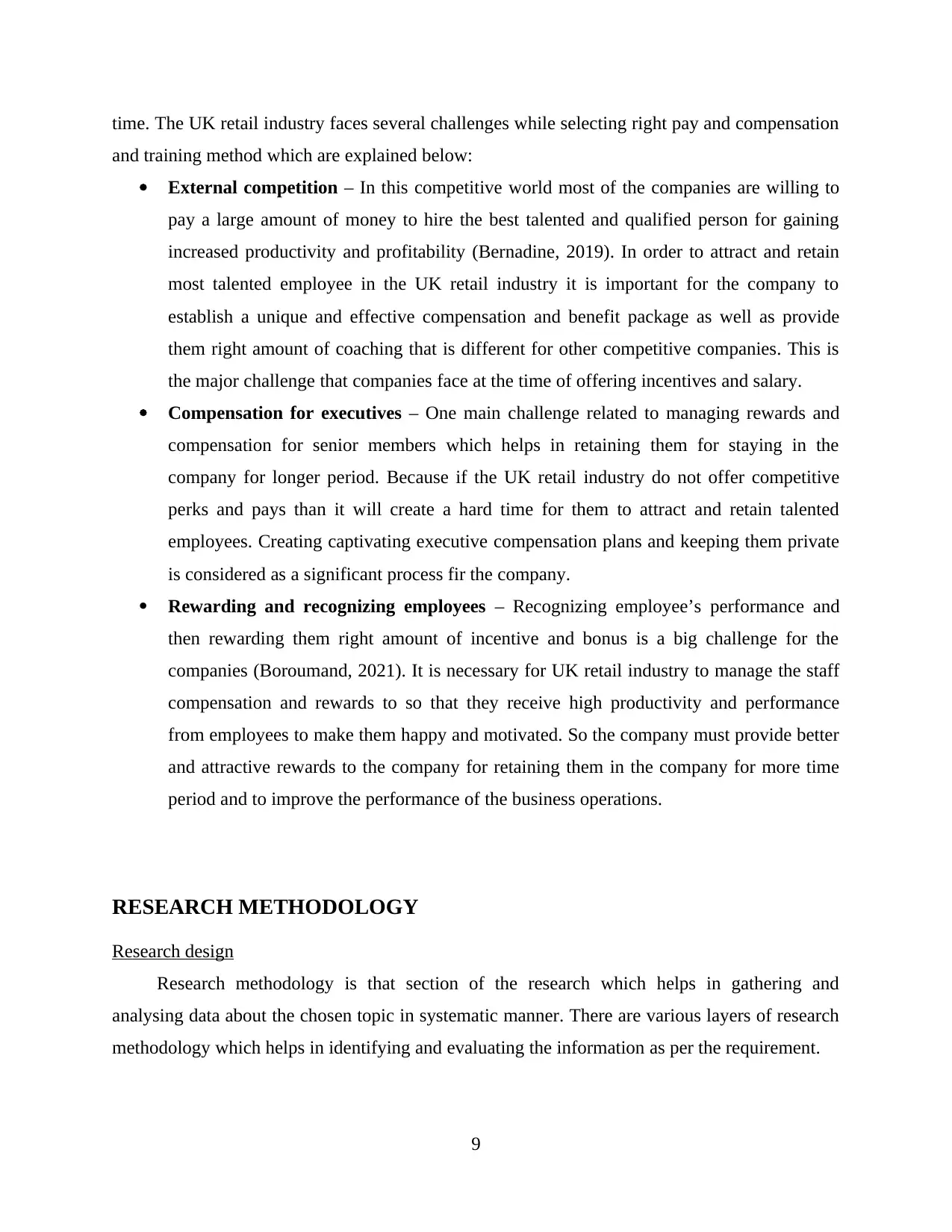
time. The UK retail industry faces several challenges while selecting right pay and compensation
and training method which are explained below:
External competition – In this competitive world most of the companies are willing to
pay a large amount of money to hire the best talented and qualified person for gaining
increased productivity and profitability (Bernadine, 2019). In order to attract and retain
most talented employee in the UK retail industry it is important for the company to
establish a unique and effective compensation and benefit package as well as provide
them right amount of coaching that is different for other competitive companies. This is
the major challenge that companies face at the time of offering incentives and salary.
Compensation for executives – One main challenge related to managing rewards and
compensation for senior members which helps in retaining them for staying in the
company for longer period. Because if the UK retail industry do not offer competitive
perks and pays than it will create a hard time for them to attract and retain talented
employees. Creating captivating executive compensation plans and keeping them private
is considered as a significant process fir the company.
Rewarding and recognizing employees – Recognizing employee’s performance and
then rewarding them right amount of incentive and bonus is a big challenge for the
companies (Boroumand, 2021). It is necessary for UK retail industry to manage the staff
compensation and rewards to so that they receive high productivity and performance
from employees to make them happy and motivated. So the company must provide better
and attractive rewards to the company for retaining them in the company for more time
period and to improve the performance of the business operations.
RESEARCH METHODOLOGY
Research design
Research methodology is that section of the research which helps in gathering and
analysing data about the chosen topic in systematic manner. There are various layers of research
methodology which helps in identifying and evaluating the information as per the requirement.
9
and training method which are explained below:
External competition – In this competitive world most of the companies are willing to
pay a large amount of money to hire the best talented and qualified person for gaining
increased productivity and profitability (Bernadine, 2019). In order to attract and retain
most talented employee in the UK retail industry it is important for the company to
establish a unique and effective compensation and benefit package as well as provide
them right amount of coaching that is different for other competitive companies. This is
the major challenge that companies face at the time of offering incentives and salary.
Compensation for executives – One main challenge related to managing rewards and
compensation for senior members which helps in retaining them for staying in the
company for longer period. Because if the UK retail industry do not offer competitive
perks and pays than it will create a hard time for them to attract and retain talented
employees. Creating captivating executive compensation plans and keeping them private
is considered as a significant process fir the company.
Rewarding and recognizing employees – Recognizing employee’s performance and
then rewarding them right amount of incentive and bonus is a big challenge for the
companies (Boroumand, 2021). It is necessary for UK retail industry to manage the staff
compensation and rewards to so that they receive high productivity and performance
from employees to make them happy and motivated. So the company must provide better
and attractive rewards to the company for retaining them in the company for more time
period and to improve the performance of the business operations.
RESEARCH METHODOLOGY
Research design
Research methodology is that section of the research which helps in gathering and
analysing data about the chosen topic in systematic manner. There are various layers of research
methodology which helps in identifying and evaluating the information as per the requirement.
9
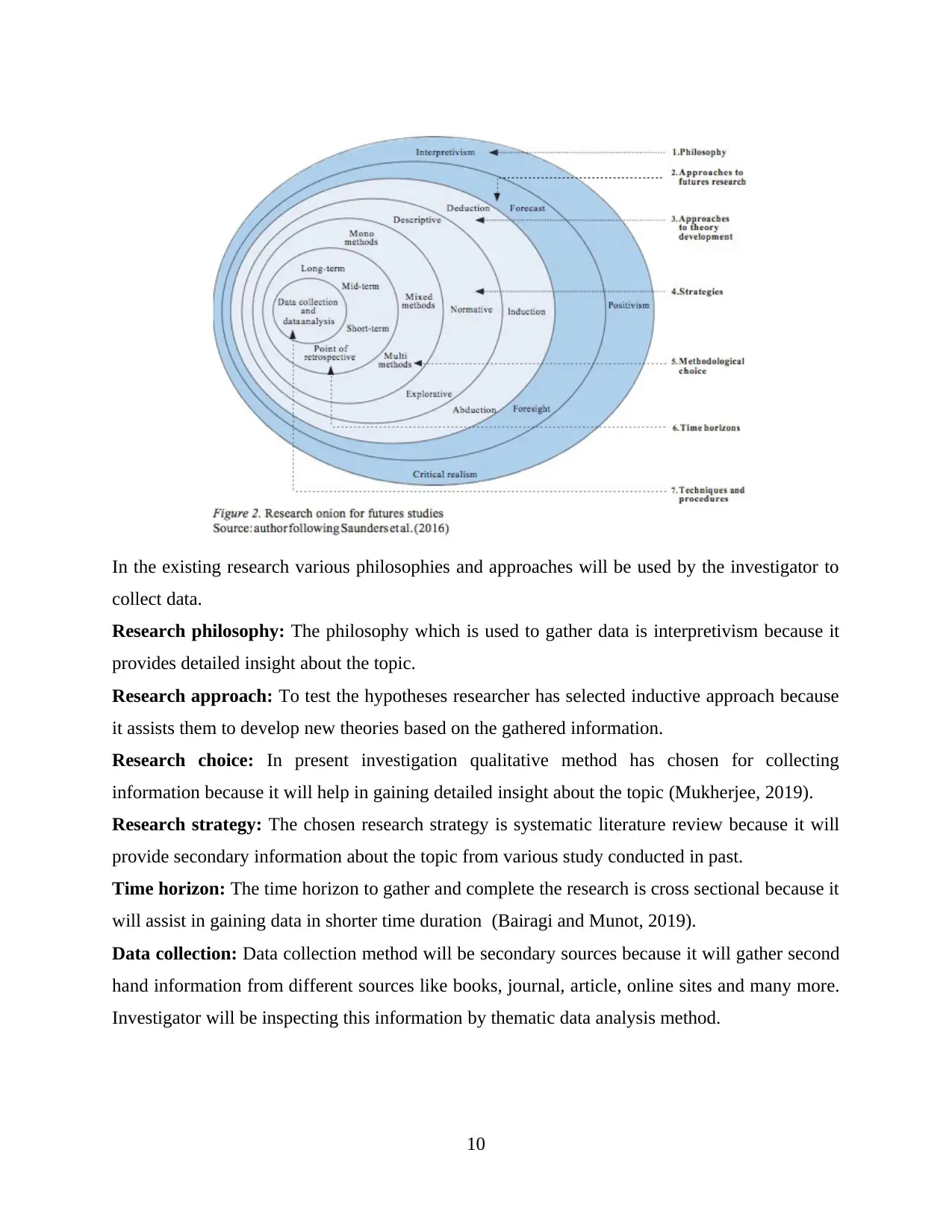
In the existing research various philosophies and approaches will be used by the investigator to
collect data.
Research philosophy: The philosophy which is used to gather data is interpretivism because it
provides detailed insight about the topic.
Research approach: To test the hypotheses researcher has selected inductive approach because
it assists them to develop new theories based on the gathered information.
Research choice: In present investigation qualitative method has chosen for collecting
information because it will help in gaining detailed insight about the topic (Mukherjee, 2019).
Research strategy: The chosen research strategy is systematic literature review because it will
provide secondary information about the topic from various study conducted in past.
Time horizon: The time horizon to gather and complete the research is cross sectional because it
will assist in gaining data in shorter time duration (Bairagi and Munot, 2019).
Data collection: Data collection method will be secondary sources because it will gather second
hand information from different sources like books, journal, article, online sites and many more.
Investigator will be inspecting this information by thematic data analysis method.
10
collect data.
Research philosophy: The philosophy which is used to gather data is interpretivism because it
provides detailed insight about the topic.
Research approach: To test the hypotheses researcher has selected inductive approach because
it assists them to develop new theories based on the gathered information.
Research choice: In present investigation qualitative method has chosen for collecting
information because it will help in gaining detailed insight about the topic (Mukherjee, 2019).
Research strategy: The chosen research strategy is systematic literature review because it will
provide secondary information about the topic from various study conducted in past.
Time horizon: The time horizon to gather and complete the research is cross sectional because it
will assist in gaining data in shorter time duration (Bairagi and Munot, 2019).
Data collection: Data collection method will be secondary sources because it will gather second
hand information from different sources like books, journal, article, online sites and many more.
Investigator will be inspecting this information by thematic data analysis method.
10
Secure Best Marks with AI Grader
Need help grading? Try our AI Grader for instant feedback on your assignments.
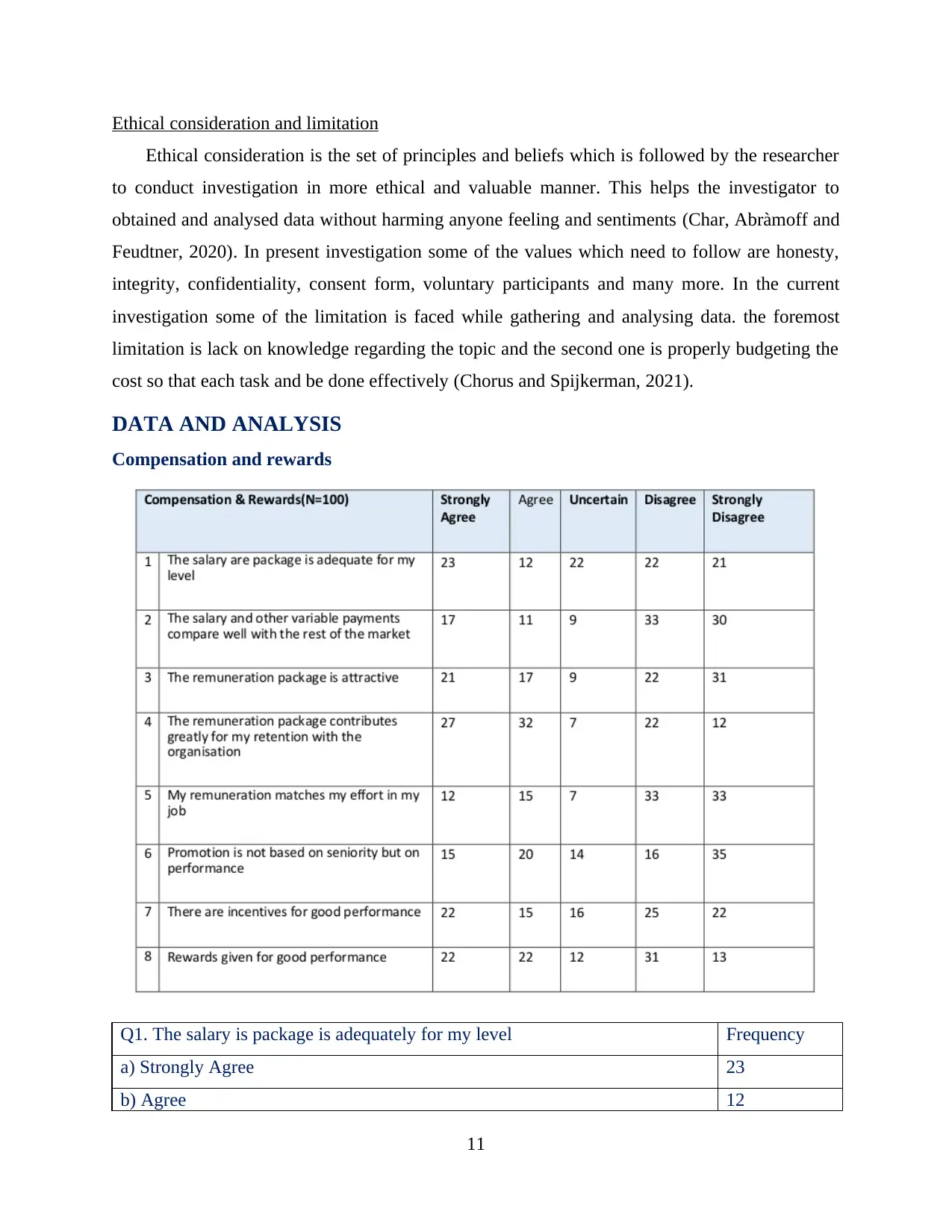
Ethical consideration and limitation
Ethical consideration is the set of principles and beliefs which is followed by the researcher
to conduct investigation in more ethical and valuable manner. This helps the investigator to
obtained and analysed data without harming anyone feeling and sentiments (Char, Abràmoff and
Feudtner, 2020). In present investigation some of the values which need to follow are honesty,
integrity, confidentiality, consent form, voluntary participants and many more. In the current
investigation some of the limitation is faced while gathering and analysing data. the foremost
limitation is lack on knowledge regarding the topic and the second one is properly budgeting the
cost so that each task and be done effectively (Chorus and Spijkerman, 2021).
DATA AND ANALYSIS
Compensation and rewards
Q1. The salary is package is adequately for my level Frequency
a) Strongly Agree 23
b) Agree 12
11
Ethical consideration is the set of principles and beliefs which is followed by the researcher
to conduct investigation in more ethical and valuable manner. This helps the investigator to
obtained and analysed data without harming anyone feeling and sentiments (Char, Abràmoff and
Feudtner, 2020). In present investigation some of the values which need to follow are honesty,
integrity, confidentiality, consent form, voluntary participants and many more. In the current
investigation some of the limitation is faced while gathering and analysing data. the foremost
limitation is lack on knowledge regarding the topic and the second one is properly budgeting the
cost so that each task and be done effectively (Chorus and Spijkerman, 2021).
DATA AND ANALYSIS
Compensation and rewards
Q1. The salary is package is adequately for my level Frequency
a) Strongly Agree 23
b) Agree 12
11
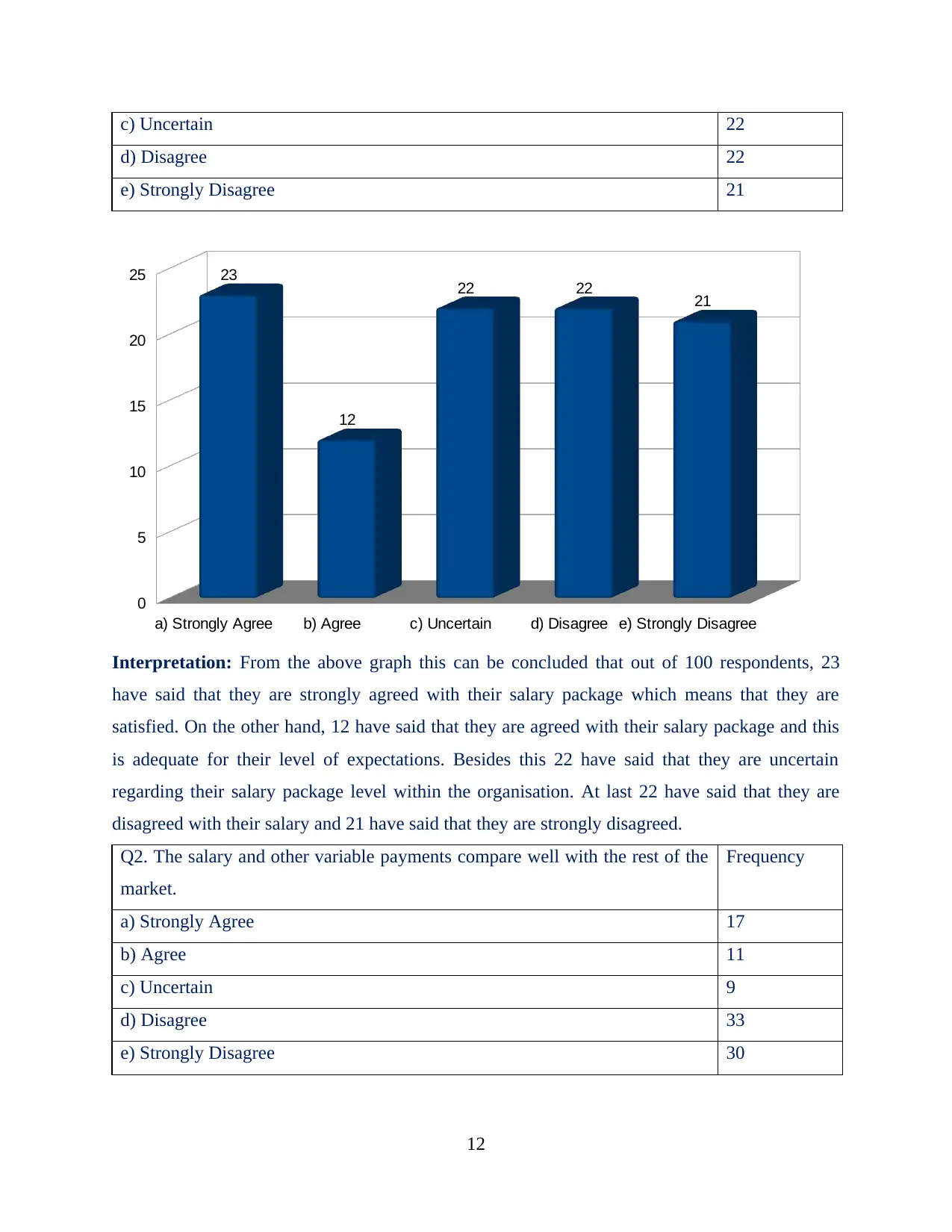
c) Uncertain 22
d) Disagree 22
e) Strongly Disagree 21
a) Strongly Agree b) Agree c) Uncertain d) Disagree e) Strongly Disagree
0
5
10
15
20
25 23
12
22 22 21
Interpretation: From the above graph this can be concluded that out of 100 respondents, 23
have said that they are strongly agreed with their salary package which means that they are
satisfied. On the other hand, 12 have said that they are agreed with their salary package and this
is adequate for their level of expectations. Besides this 22 have said that they are uncertain
regarding their salary package level within the organisation. At last 22 have said that they are
disagreed with their salary and 21 have said that they are strongly disagreed.
Q2. The salary and other variable payments compare well with the rest of the
market.
Frequency
a) Strongly Agree 17
b) Agree 11
c) Uncertain 9
d) Disagree 33
e) Strongly Disagree 30
12
d) Disagree 22
e) Strongly Disagree 21
a) Strongly Agree b) Agree c) Uncertain d) Disagree e) Strongly Disagree
0
5
10
15
20
25 23
12
22 22 21
Interpretation: From the above graph this can be concluded that out of 100 respondents, 23
have said that they are strongly agreed with their salary package which means that they are
satisfied. On the other hand, 12 have said that they are agreed with their salary package and this
is adequate for their level of expectations. Besides this 22 have said that they are uncertain
regarding their salary package level within the organisation. At last 22 have said that they are
disagreed with their salary and 21 have said that they are strongly disagreed.
Q2. The salary and other variable payments compare well with the rest of the
market.
Frequency
a) Strongly Agree 17
b) Agree 11
c) Uncertain 9
d) Disagree 33
e) Strongly Disagree 30
12
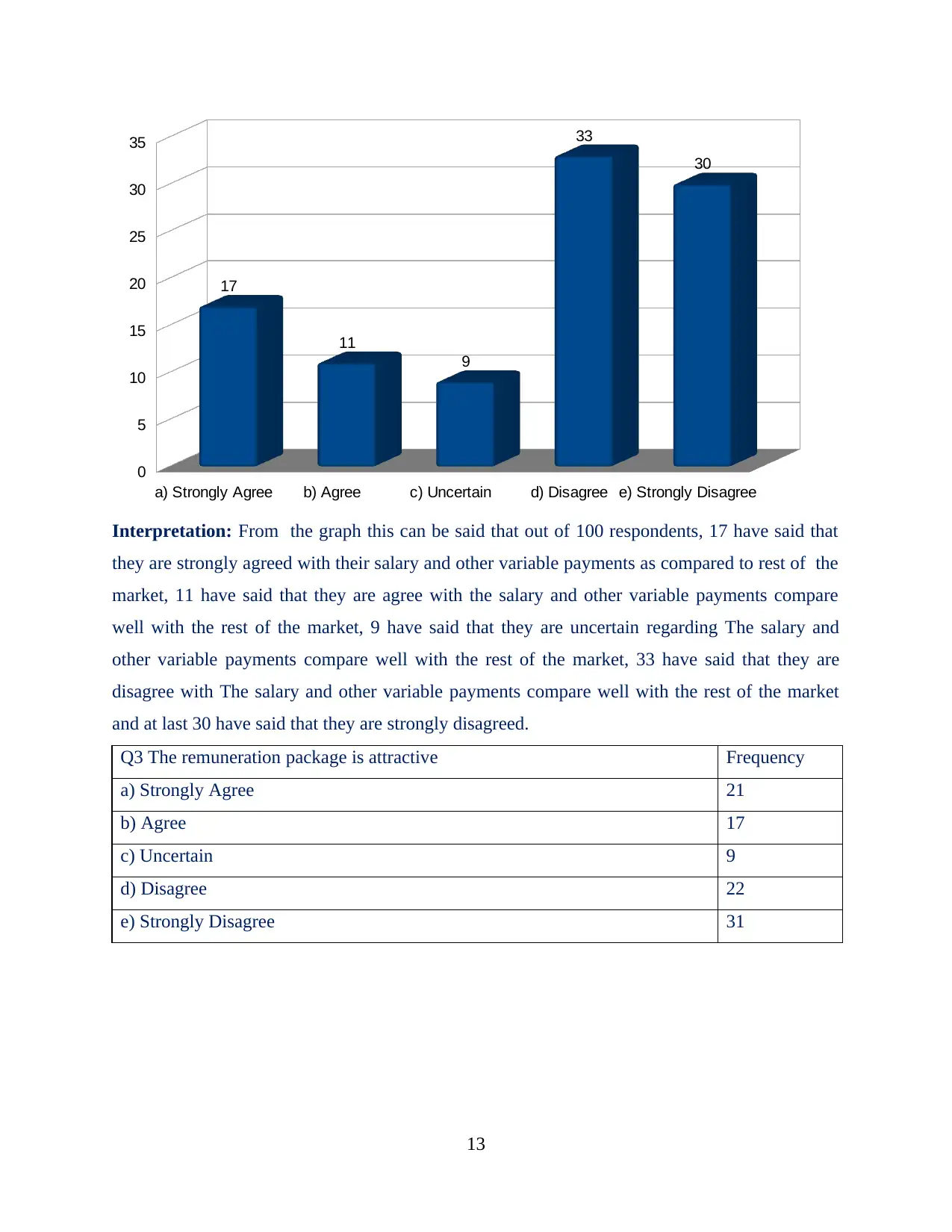
a) Strongly Agree b) Agree c) Uncertain d) Disagree e) Strongly Disagree
0
5
10
15
20
25
30
35
17
11
9
33
30
Interpretation: From the graph this can be said that out of 100 respondents, 17 have said that
they are strongly agreed with their salary and other variable payments as compared to rest of the
market, 11 have said that they are agree with the salary and other variable payments compare
well with the rest of the market, 9 have said that they are uncertain regarding The salary and
other variable payments compare well with the rest of the market, 33 have said that they are
disagree with The salary and other variable payments compare well with the rest of the market
and at last 30 have said that they are strongly disagreed.
Q3 The remuneration package is attractive Frequency
a) Strongly Agree 21
b) Agree 17
c) Uncertain 9
d) Disagree 22
e) Strongly Disagree 31
13
0
5
10
15
20
25
30
35
17
11
9
33
30
Interpretation: From the graph this can be said that out of 100 respondents, 17 have said that
they are strongly agreed with their salary and other variable payments as compared to rest of the
market, 11 have said that they are agree with the salary and other variable payments compare
well with the rest of the market, 9 have said that they are uncertain regarding The salary and
other variable payments compare well with the rest of the market, 33 have said that they are
disagree with The salary and other variable payments compare well with the rest of the market
and at last 30 have said that they are strongly disagreed.
Q3 The remuneration package is attractive Frequency
a) Strongly Agree 21
b) Agree 17
c) Uncertain 9
d) Disagree 22
e) Strongly Disagree 31
13
Paraphrase This Document
Need a fresh take? Get an instant paraphrase of this document with our AI Paraphraser
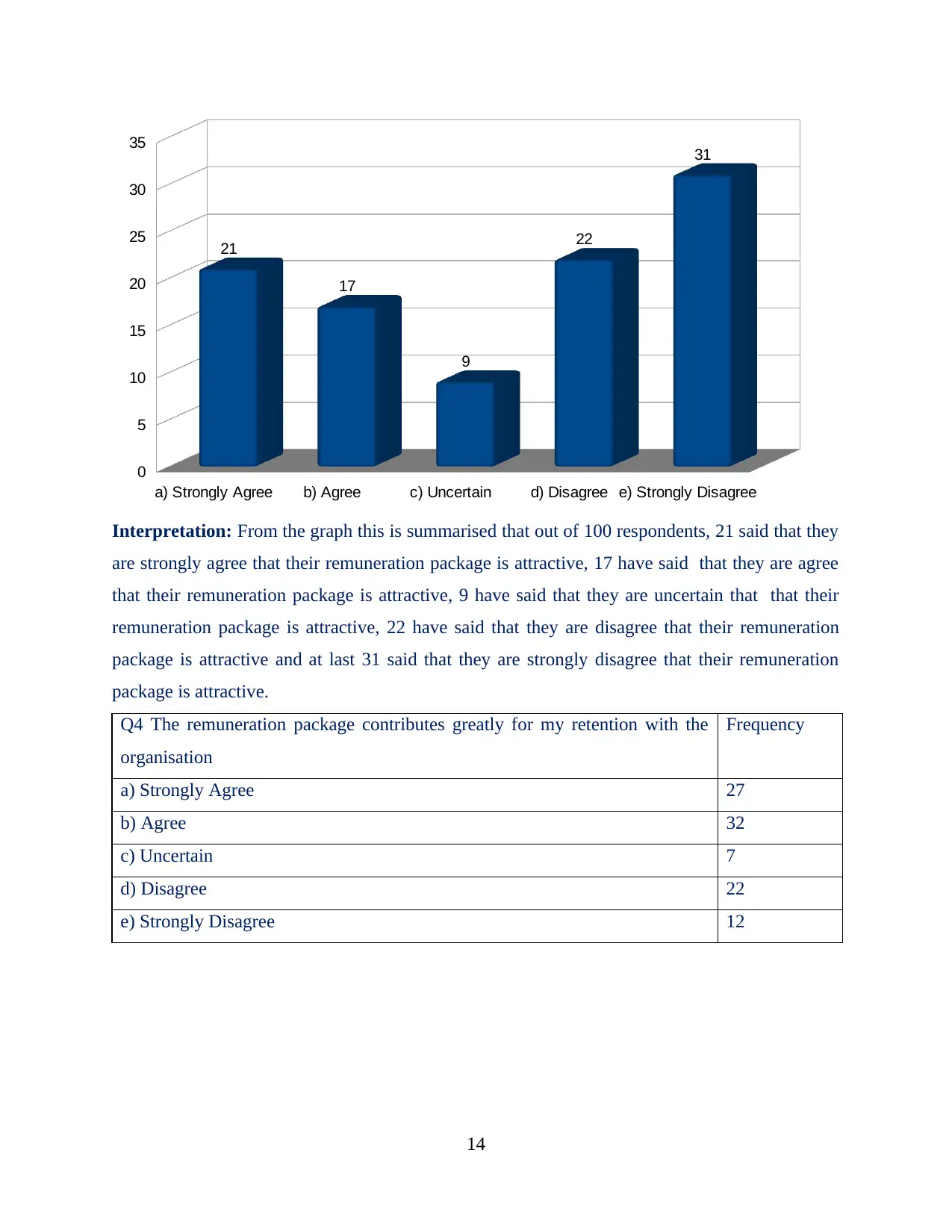
a) Strongly Agree b) Agree c) Uncertain d) Disagree e) Strongly Disagree
0
5
10
15
20
25
30
35
21
17
9
22
31
Interpretation: From the graph this is summarised that out of 100 respondents, 21 said that they
are strongly agree that their remuneration package is attractive, 17 have said that they are agree
that their remuneration package is attractive, 9 have said that they are uncertain that that their
remuneration package is attractive, 22 have said that they are disagree that their remuneration
package is attractive and at last 31 said that they are strongly disagree that their remuneration
package is attractive.
Q4 The remuneration package contributes greatly for my retention with the
organisation
Frequency
a) Strongly Agree 27
b) Agree 32
c) Uncertain 7
d) Disagree 22
e) Strongly Disagree 12
14
0
5
10
15
20
25
30
35
21
17
9
22
31
Interpretation: From the graph this is summarised that out of 100 respondents, 21 said that they
are strongly agree that their remuneration package is attractive, 17 have said that they are agree
that their remuneration package is attractive, 9 have said that they are uncertain that that their
remuneration package is attractive, 22 have said that they are disagree that their remuneration
package is attractive and at last 31 said that they are strongly disagree that their remuneration
package is attractive.
Q4 The remuneration package contributes greatly for my retention with the
organisation
Frequency
a) Strongly Agree 27
b) Agree 32
c) Uncertain 7
d) Disagree 22
e) Strongly Disagree 12
14
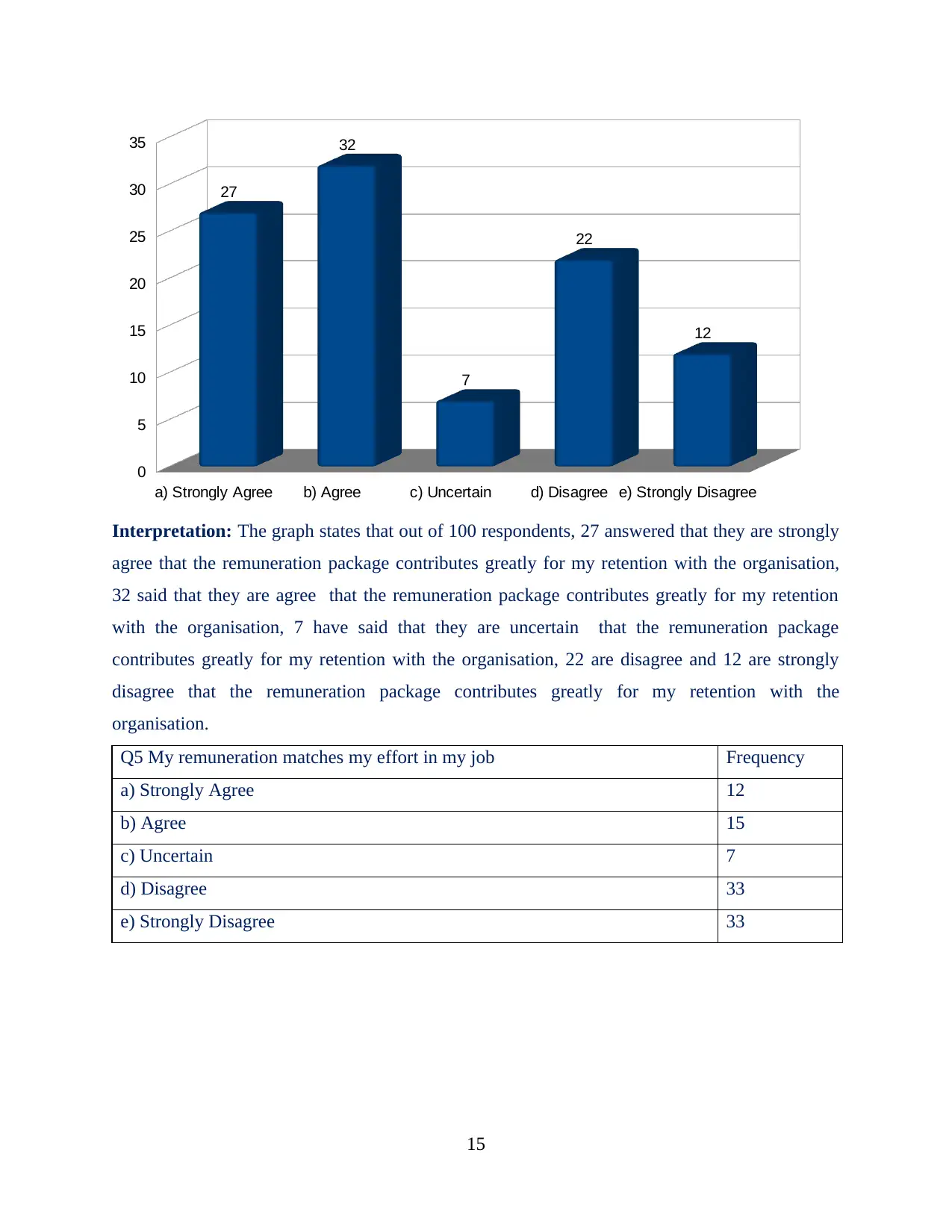
a) Strongly Agree b) Agree c) Uncertain d) Disagree e) Strongly Disagree
0
5
10
15
20
25
30
35
27
32
7
22
12
Interpretation: The graph states that out of 100 respondents, 27 answered that they are strongly
agree that the remuneration package contributes greatly for my retention with the organisation,
32 said that they are agree that the remuneration package contributes greatly for my retention
with the organisation, 7 have said that they are uncertain that the remuneration package
contributes greatly for my retention with the organisation, 22 are disagree and 12 are strongly
disagree that the remuneration package contributes greatly for my retention with the
organisation.
Q5 My remuneration matches my effort in my job Frequency
a) Strongly Agree 12
b) Agree 15
c) Uncertain 7
d) Disagree 33
e) Strongly Disagree 33
15
0
5
10
15
20
25
30
35
27
32
7
22
12
Interpretation: The graph states that out of 100 respondents, 27 answered that they are strongly
agree that the remuneration package contributes greatly for my retention with the organisation,
32 said that they are agree that the remuneration package contributes greatly for my retention
with the organisation, 7 have said that they are uncertain that the remuneration package
contributes greatly for my retention with the organisation, 22 are disagree and 12 are strongly
disagree that the remuneration package contributes greatly for my retention with the
organisation.
Q5 My remuneration matches my effort in my job Frequency
a) Strongly Agree 12
b) Agree 15
c) Uncertain 7
d) Disagree 33
e) Strongly Disagree 33
15
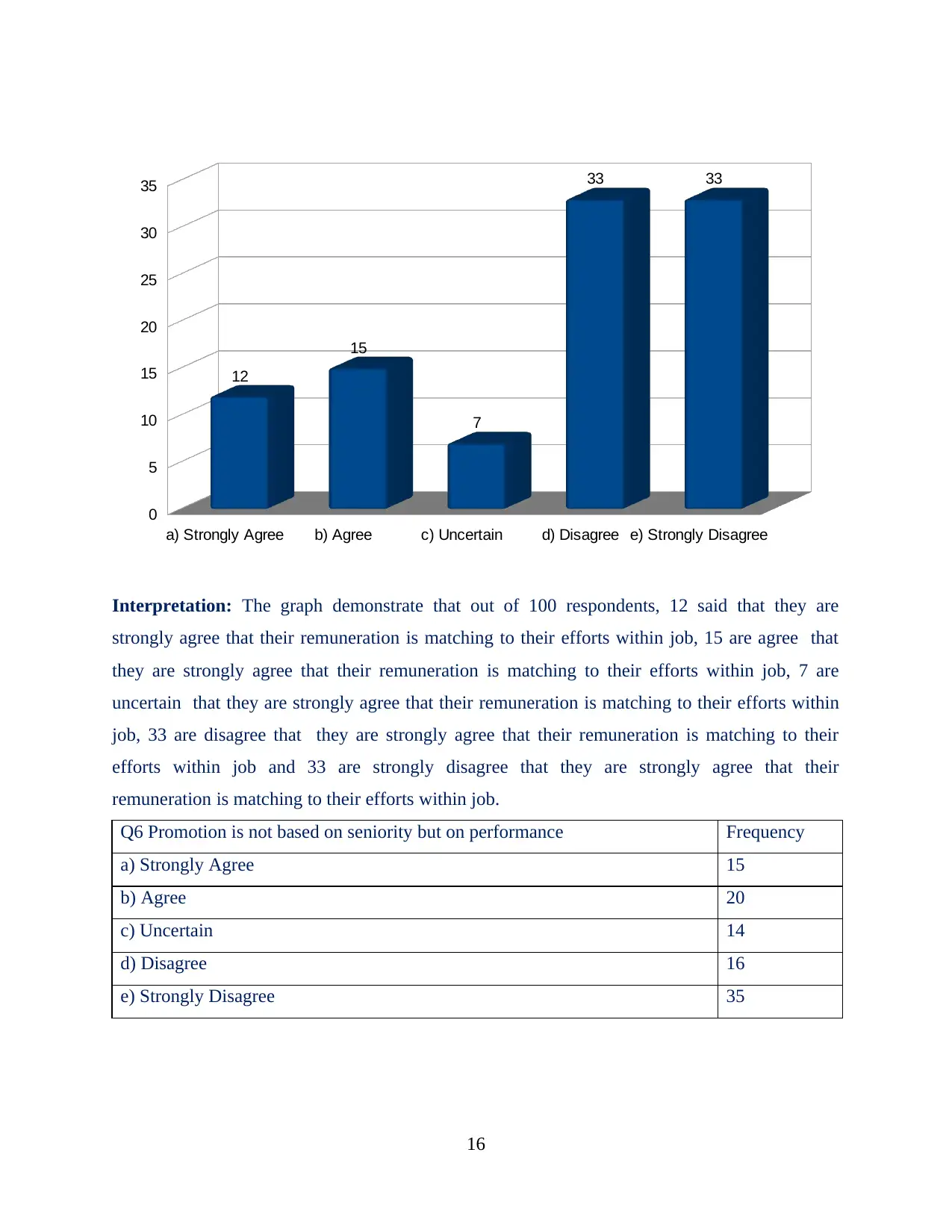
Interpretation: The graph demonstrate that out of 100 respondents, 12 said that they are
strongly agree that their remuneration is matching to their efforts within job, 15 are agree that
they are strongly agree that their remuneration is matching to their efforts within job, 7 are
uncertain that they are strongly agree that their remuneration is matching to their efforts within
job, 33 are disagree that they are strongly agree that their remuneration is matching to their
efforts within job and 33 are strongly disagree that they are strongly agree that their
remuneration is matching to their efforts within job.
Q6 Promotion is not based on seniority but on performance Frequency
a) Strongly Agree 15
b) Agree 20
c) Uncertain 14
d) Disagree 16
e) Strongly Disagree 35
16
a) Strongly Agree b) Agree c) Uncertain d) Disagree e) Strongly Disagree
0
5
10
15
20
25
30
35
12
15
7
33 33
strongly agree that their remuneration is matching to their efforts within job, 15 are agree that
they are strongly agree that their remuneration is matching to their efforts within job, 7 are
uncertain that they are strongly agree that their remuneration is matching to their efforts within
job, 33 are disagree that they are strongly agree that their remuneration is matching to their
efforts within job and 33 are strongly disagree that they are strongly agree that their
remuneration is matching to their efforts within job.
Q6 Promotion is not based on seniority but on performance Frequency
a) Strongly Agree 15
b) Agree 20
c) Uncertain 14
d) Disagree 16
e) Strongly Disagree 35
16
a) Strongly Agree b) Agree c) Uncertain d) Disagree e) Strongly Disagree
0
5
10
15
20
25
30
35
12
15
7
33 33
Secure Best Marks with AI Grader
Need help grading? Try our AI Grader for instant feedback on your assignments.
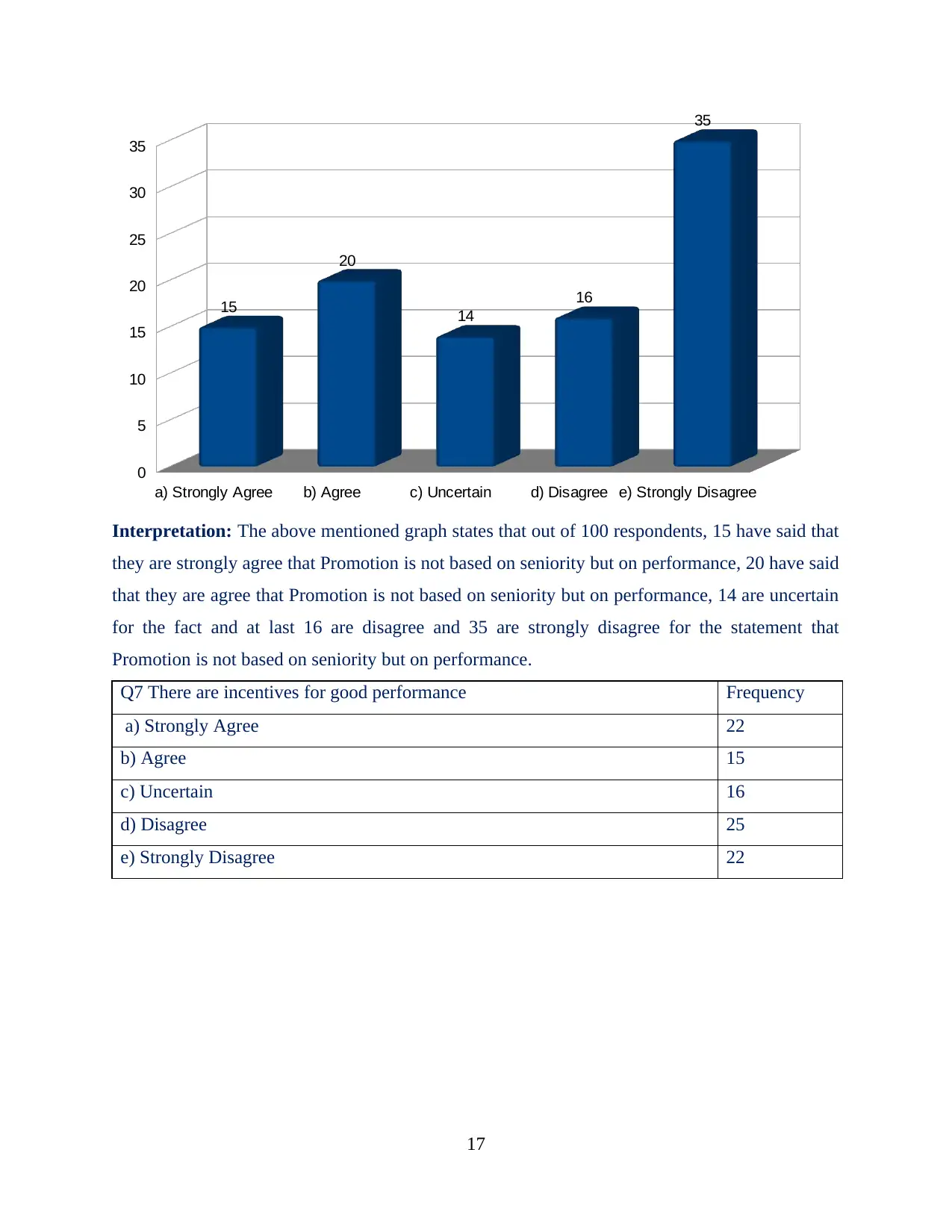
a) Strongly Agree b) Agree c) Uncertain d) Disagree e) Strongly Disagree
0
5
10
15
20
25
30
35
15
20
14
16
35
Interpretation: The above mentioned graph states that out of 100 respondents, 15 have said that
they are strongly agree that Promotion is not based on seniority but on performance, 20 have said
that they are agree that Promotion is not based on seniority but on performance, 14 are uncertain
for the fact and at last 16 are disagree and 35 are strongly disagree for the statement that
Promotion is not based on seniority but on performance.
Q7 There are incentives for good performance Frequency
a) Strongly Agree 22
b) Agree 15
c) Uncertain 16
d) Disagree 25
e) Strongly Disagree 22
17
0
5
10
15
20
25
30
35
15
20
14
16
35
Interpretation: The above mentioned graph states that out of 100 respondents, 15 have said that
they are strongly agree that Promotion is not based on seniority but on performance, 20 have said
that they are agree that Promotion is not based on seniority but on performance, 14 are uncertain
for the fact and at last 16 are disagree and 35 are strongly disagree for the statement that
Promotion is not based on seniority but on performance.
Q7 There are incentives for good performance Frequency
a) Strongly Agree 22
b) Agree 15
c) Uncertain 16
d) Disagree 25
e) Strongly Disagree 22
17
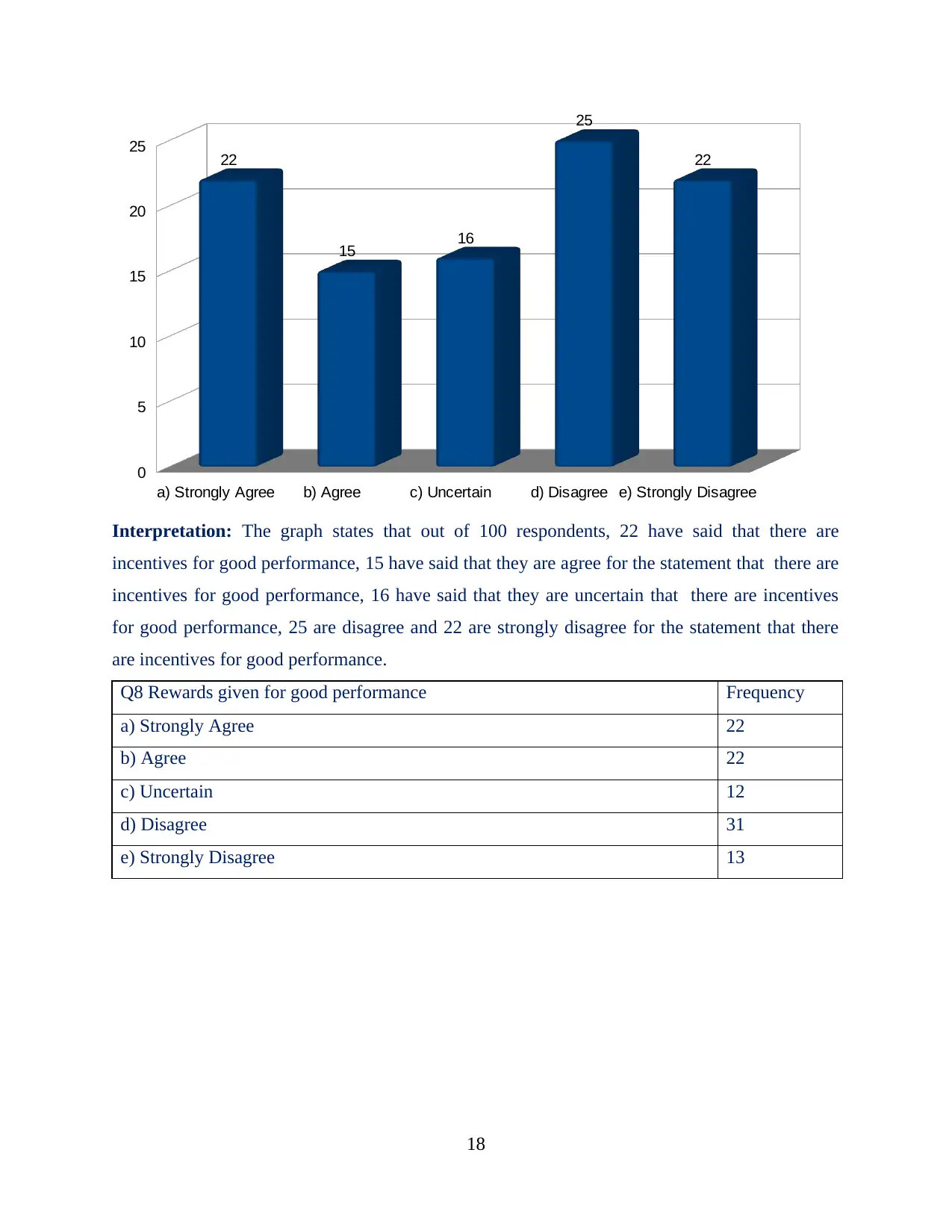
a) Strongly Agree b) Agree c) Uncertain d) Disagree e) Strongly Disagree
0
5
10
15
20
25 22
15 16
25
22
Interpretation: The graph states that out of 100 respondents, 22 have said that there are
incentives for good performance, 15 have said that they are agree for the statement that there are
incentives for good performance, 16 have said that they are uncertain that there are incentives
for good performance, 25 are disagree and 22 are strongly disagree for the statement that there
are incentives for good performance.
Q8 Rewards given for good performance Frequency
a) Strongly Agree 22
b) Agree 22
c) Uncertain 12
d) Disagree 31
e) Strongly Disagree 13
18
0
5
10
15
20
25 22
15 16
25
22
Interpretation: The graph states that out of 100 respondents, 22 have said that there are
incentives for good performance, 15 have said that they are agree for the statement that there are
incentives for good performance, 16 have said that they are uncertain that there are incentives
for good performance, 25 are disagree and 22 are strongly disagree for the statement that there
are incentives for good performance.
Q8 Rewards given for good performance Frequency
a) Strongly Agree 22
b) Agree 22
c) Uncertain 12
d) Disagree 31
e) Strongly Disagree 13
18
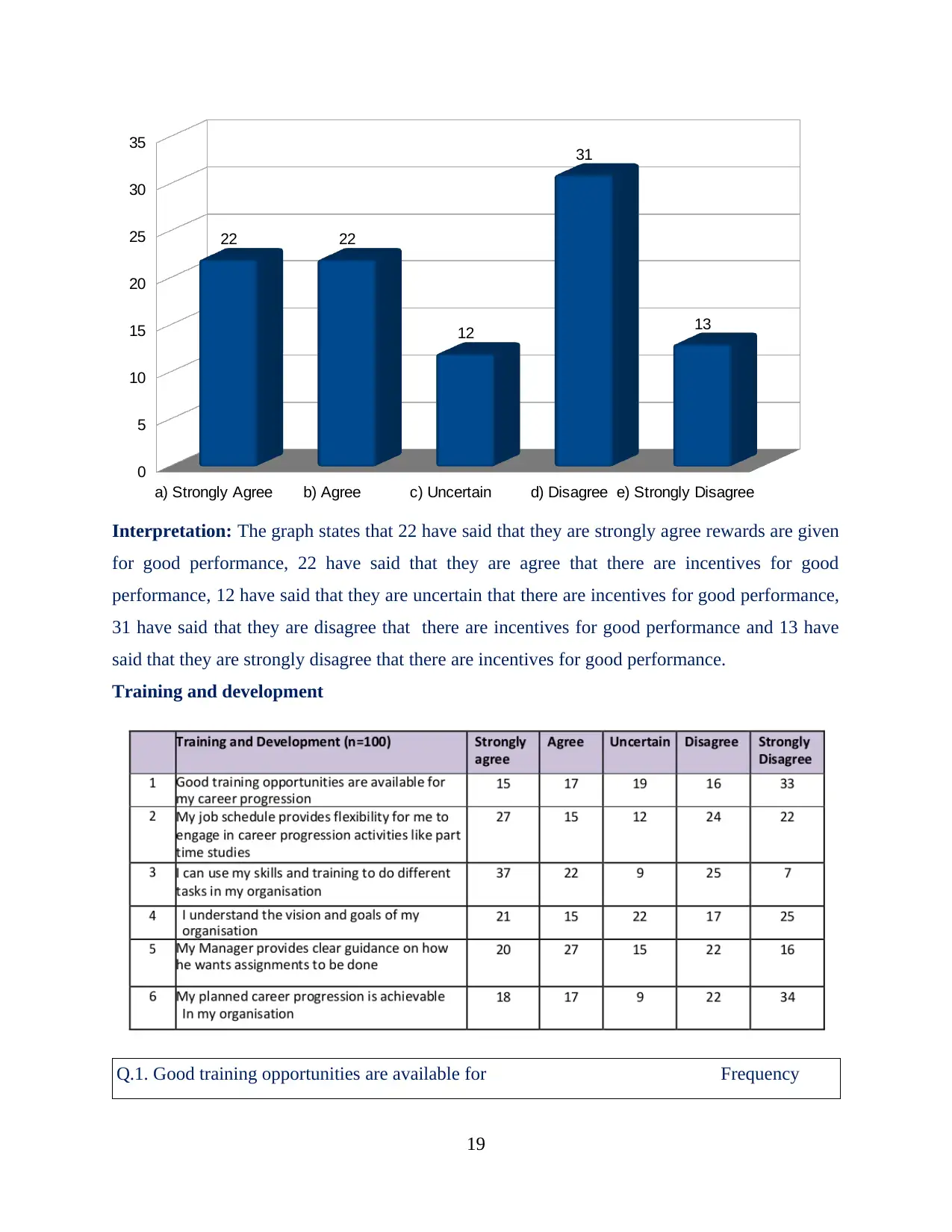
a) Strongly Agree b) Agree c) Uncertain d) Disagree e) Strongly Disagree
0
5
10
15
20
25
30
35
22 22
12
31
13
Interpretation: The graph states that 22 have said that they are strongly agree rewards are given
for good performance, 22 have said that they are agree that there are incentives for good
performance, 12 have said that they are uncertain that there are incentives for good performance,
31 have said that they are disagree that there are incentives for good performance and 13 have
said that they are strongly disagree that there are incentives for good performance.
Training and development
Q.1. Good training opportunities are available for Frequency
19
0
5
10
15
20
25
30
35
22 22
12
31
13
Interpretation: The graph states that 22 have said that they are strongly agree rewards are given
for good performance, 22 have said that they are agree that there are incentives for good
performance, 12 have said that they are uncertain that there are incentives for good performance,
31 have said that they are disagree that there are incentives for good performance and 13 have
said that they are strongly disagree that there are incentives for good performance.
Training and development
Q.1. Good training opportunities are available for Frequency
19
Paraphrase This Document
Need a fresh take? Get an instant paraphrase of this document with our AI Paraphraser
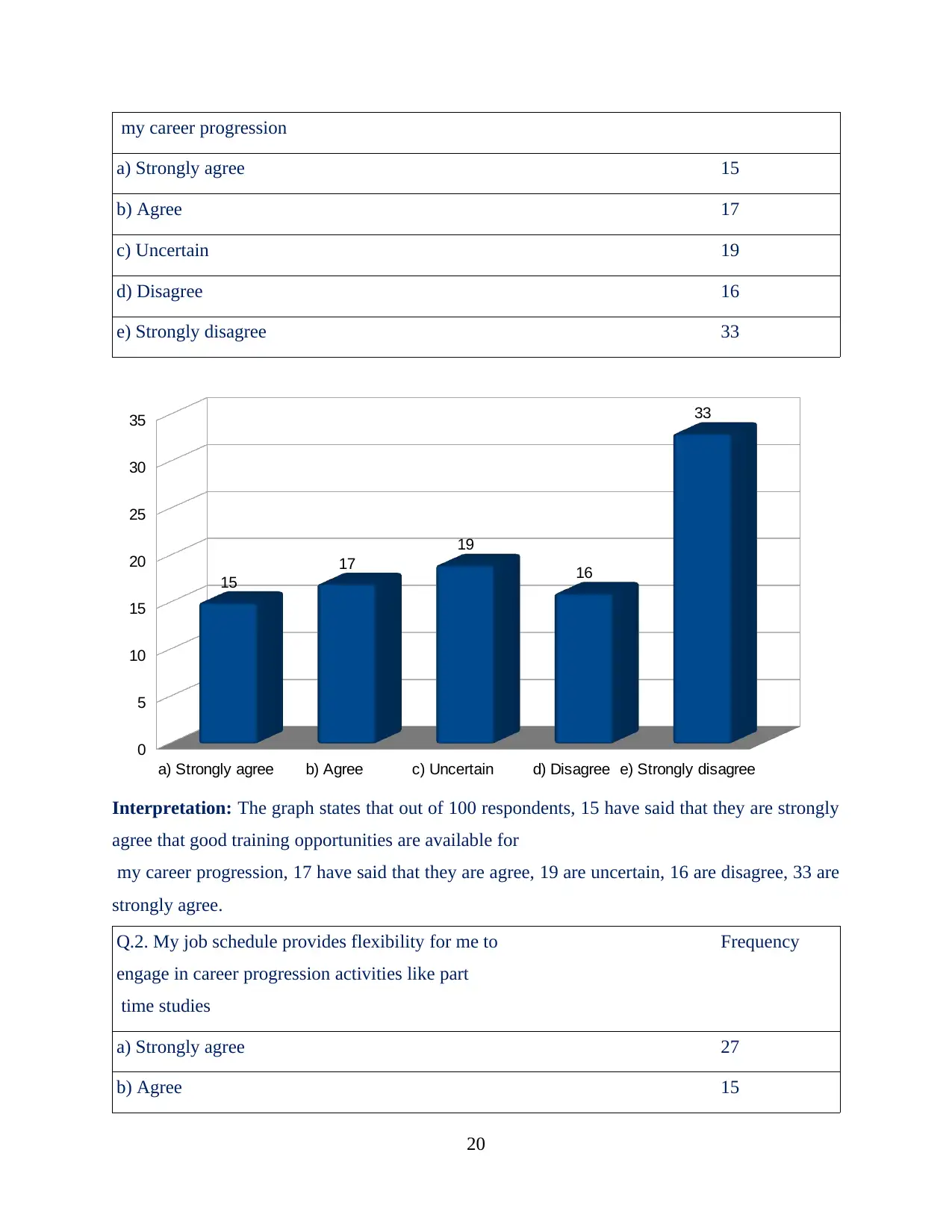
my career progression
a) Strongly agree 15
b) Agree 17
c) Uncertain 19
d) Disagree 16
e) Strongly disagree 33
a) Strongly agree b) Agree c) Uncertain d) Disagree e) Strongly disagree
0
5
10
15
20
25
30
35
15
17
19
16
33
Interpretation: The graph states that out of 100 respondents, 15 have said that they are strongly
agree that good training opportunities are available for
my career progression, 17 have said that they are agree, 19 are uncertain, 16 are disagree, 33 are
strongly agree.
Q.2. My job schedule provides flexibility for me to
engage in career progression activities like part
time studies
Frequency
a) Strongly agree 27
b) Agree 15
20
a) Strongly agree 15
b) Agree 17
c) Uncertain 19
d) Disagree 16
e) Strongly disagree 33
a) Strongly agree b) Agree c) Uncertain d) Disagree e) Strongly disagree
0
5
10
15
20
25
30
35
15
17
19
16
33
Interpretation: The graph states that out of 100 respondents, 15 have said that they are strongly
agree that good training opportunities are available for
my career progression, 17 have said that they are agree, 19 are uncertain, 16 are disagree, 33 are
strongly agree.
Q.2. My job schedule provides flexibility for me to
engage in career progression activities like part
time studies
Frequency
a) Strongly agree 27
b) Agree 15
20
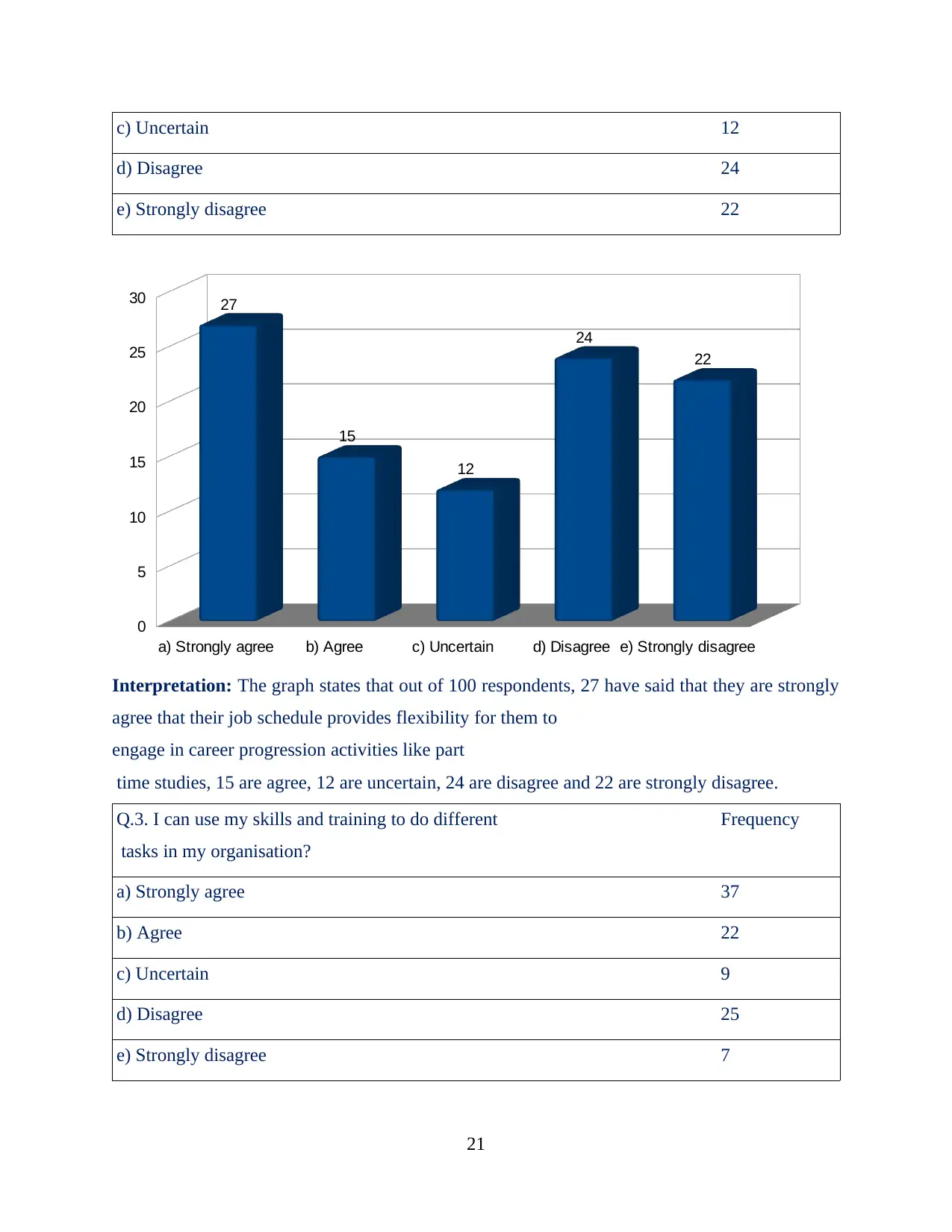
c) Uncertain 12
d) Disagree 24
e) Strongly disagree 22
a) Strongly agree b) Agree c) Uncertain d) Disagree e) Strongly disagree
0
5
10
15
20
25
30 27
15
12
24
22
Interpretation: The graph states that out of 100 respondents, 27 have said that they are strongly
agree that their job schedule provides flexibility for them to
engage in career progression activities like part
time studies, 15 are agree, 12 are uncertain, 24 are disagree and 22 are strongly disagree.
Q.3. I can use my skills and training to do different
tasks in my organisation?
Frequency
a) Strongly agree 37
b) Agree 22
c) Uncertain 9
d) Disagree 25
e) Strongly disagree 7
21
d) Disagree 24
e) Strongly disagree 22
a) Strongly agree b) Agree c) Uncertain d) Disagree e) Strongly disagree
0
5
10
15
20
25
30 27
15
12
24
22
Interpretation: The graph states that out of 100 respondents, 27 have said that they are strongly
agree that their job schedule provides flexibility for them to
engage in career progression activities like part
time studies, 15 are agree, 12 are uncertain, 24 are disagree and 22 are strongly disagree.
Q.3. I can use my skills and training to do different
tasks in my organisation?
Frequency
a) Strongly agree 37
b) Agree 22
c) Uncertain 9
d) Disagree 25
e) Strongly disagree 7
21
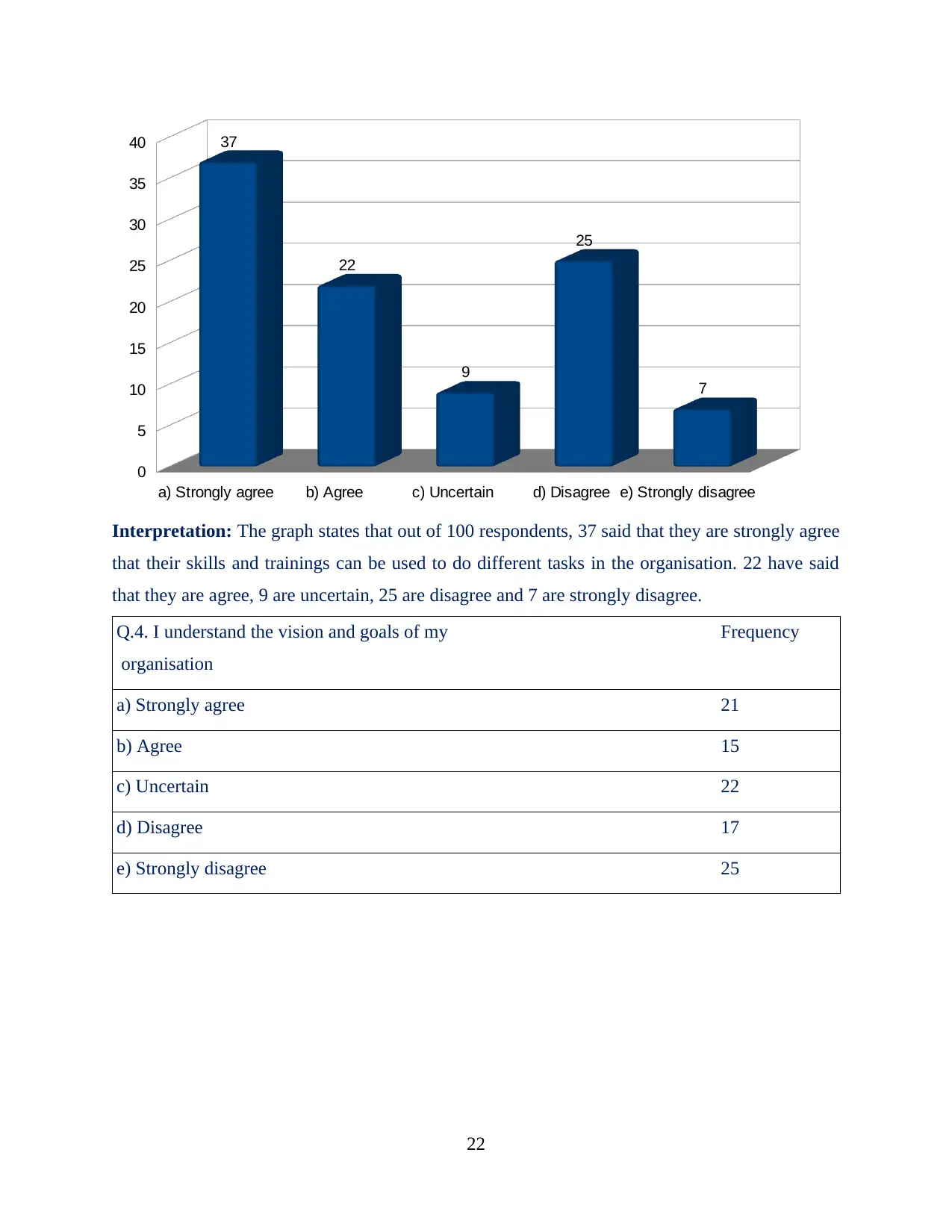
a) Strongly agree b) Agree c) Uncertain d) Disagree e) Strongly disagree
0
5
10
15
20
25
30
35
40 37
22
9
25
7
Interpretation: The graph states that out of 100 respondents, 37 said that they are strongly agree
that their skills and trainings can be used to do different tasks in the organisation. 22 have said
that they are agree, 9 are uncertain, 25 are disagree and 7 are strongly disagree.
Q.4. I understand the vision and goals of my
organisation
Frequency
a) Strongly agree 21
b) Agree 15
c) Uncertain 22
d) Disagree 17
e) Strongly disagree 25
22
0
5
10
15
20
25
30
35
40 37
22
9
25
7
Interpretation: The graph states that out of 100 respondents, 37 said that they are strongly agree
that their skills and trainings can be used to do different tasks in the organisation. 22 have said
that they are agree, 9 are uncertain, 25 are disagree and 7 are strongly disagree.
Q.4. I understand the vision and goals of my
organisation
Frequency
a) Strongly agree 21
b) Agree 15
c) Uncertain 22
d) Disagree 17
e) Strongly disagree 25
22
Secure Best Marks with AI Grader
Need help grading? Try our AI Grader for instant feedback on your assignments.
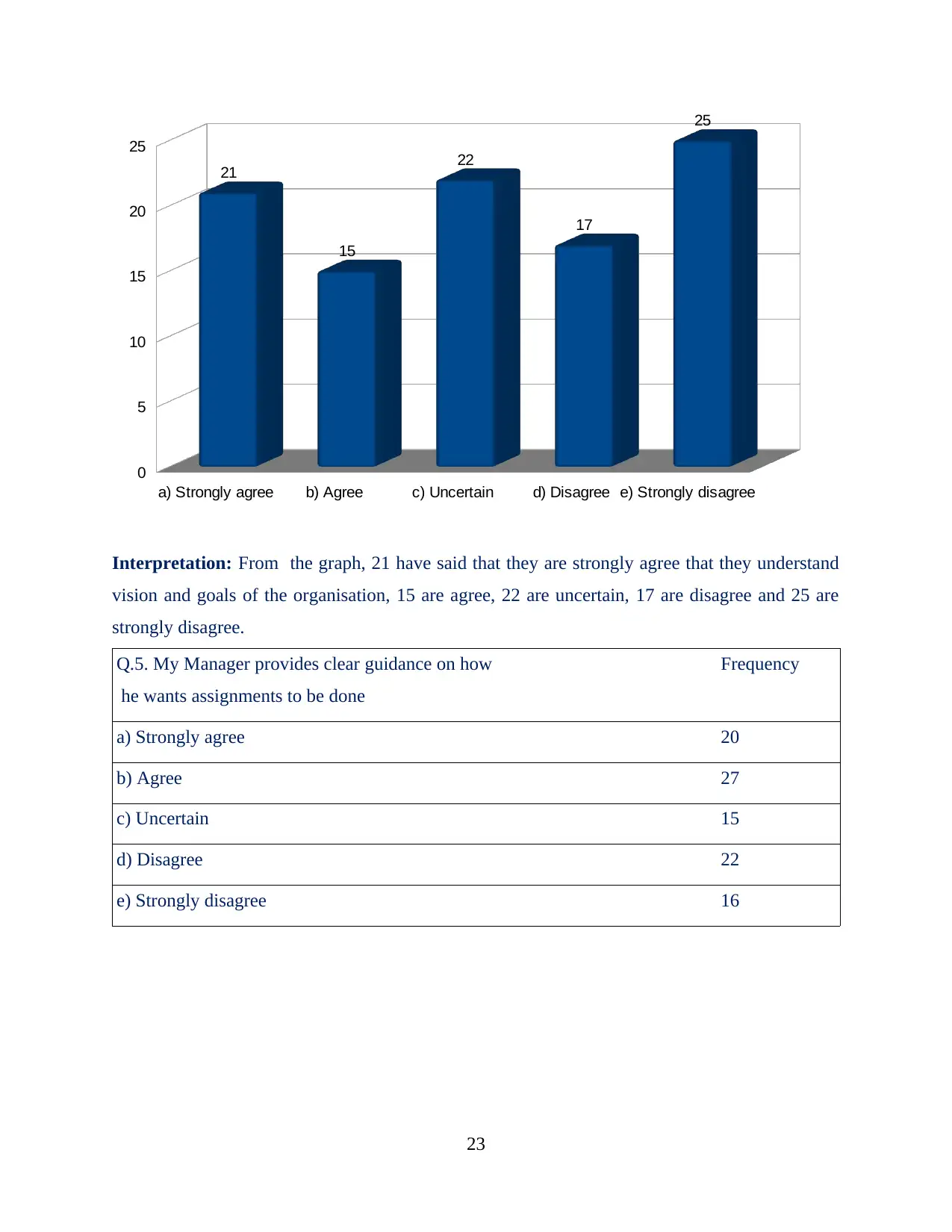
a) Strongly agree b) Agree c) Uncertain d) Disagree e) Strongly disagree
0
5
10
15
20
25
21
15
22
17
25
Interpretation: From the graph, 21 have said that they are strongly agree that they understand
vision and goals of the organisation, 15 are agree, 22 are uncertain, 17 are disagree and 25 are
strongly disagree.
Q.5. My Manager provides clear guidance on how
he wants assignments to be done
Frequency
a) Strongly agree 20
b) Agree 27
c) Uncertain 15
d) Disagree 22
e) Strongly disagree 16
23
0
5
10
15
20
25
21
15
22
17
25
Interpretation: From the graph, 21 have said that they are strongly agree that they understand
vision and goals of the organisation, 15 are agree, 22 are uncertain, 17 are disagree and 25 are
strongly disagree.
Q.5. My Manager provides clear guidance on how
he wants assignments to be done
Frequency
a) Strongly agree 20
b) Agree 27
c) Uncertain 15
d) Disagree 22
e) Strongly disagree 16
23
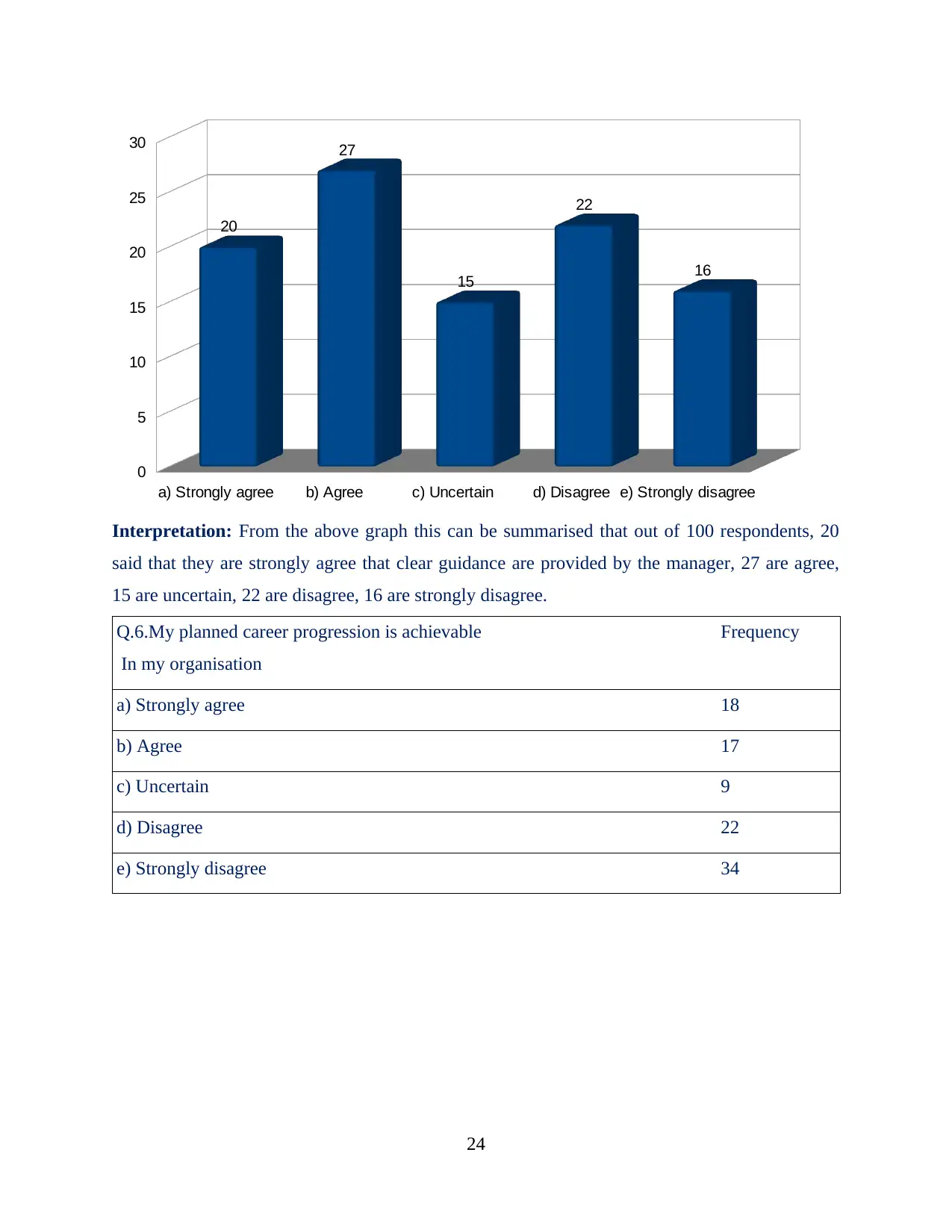
a) Strongly agree b) Agree c) Uncertain d) Disagree e) Strongly disagree
0
5
10
15
20
25
30
20
27
15
22
16
Interpretation: From the above graph this can be summarised that out of 100 respondents, 20
said that they are strongly agree that clear guidance are provided by the manager, 27 are agree,
15 are uncertain, 22 are disagree, 16 are strongly disagree.
Q.6.My planned career progression is achievable
In my organisation
Frequency
a) Strongly agree 18
b) Agree 17
c) Uncertain 9
d) Disagree 22
e) Strongly disagree 34
24
0
5
10
15
20
25
30
20
27
15
22
16
Interpretation: From the above graph this can be summarised that out of 100 respondents, 20
said that they are strongly agree that clear guidance are provided by the manager, 27 are agree,
15 are uncertain, 22 are disagree, 16 are strongly disagree.
Q.6.My planned career progression is achievable
In my organisation
Frequency
a) Strongly agree 18
b) Agree 17
c) Uncertain 9
d) Disagree 22
e) Strongly disagree 34
24
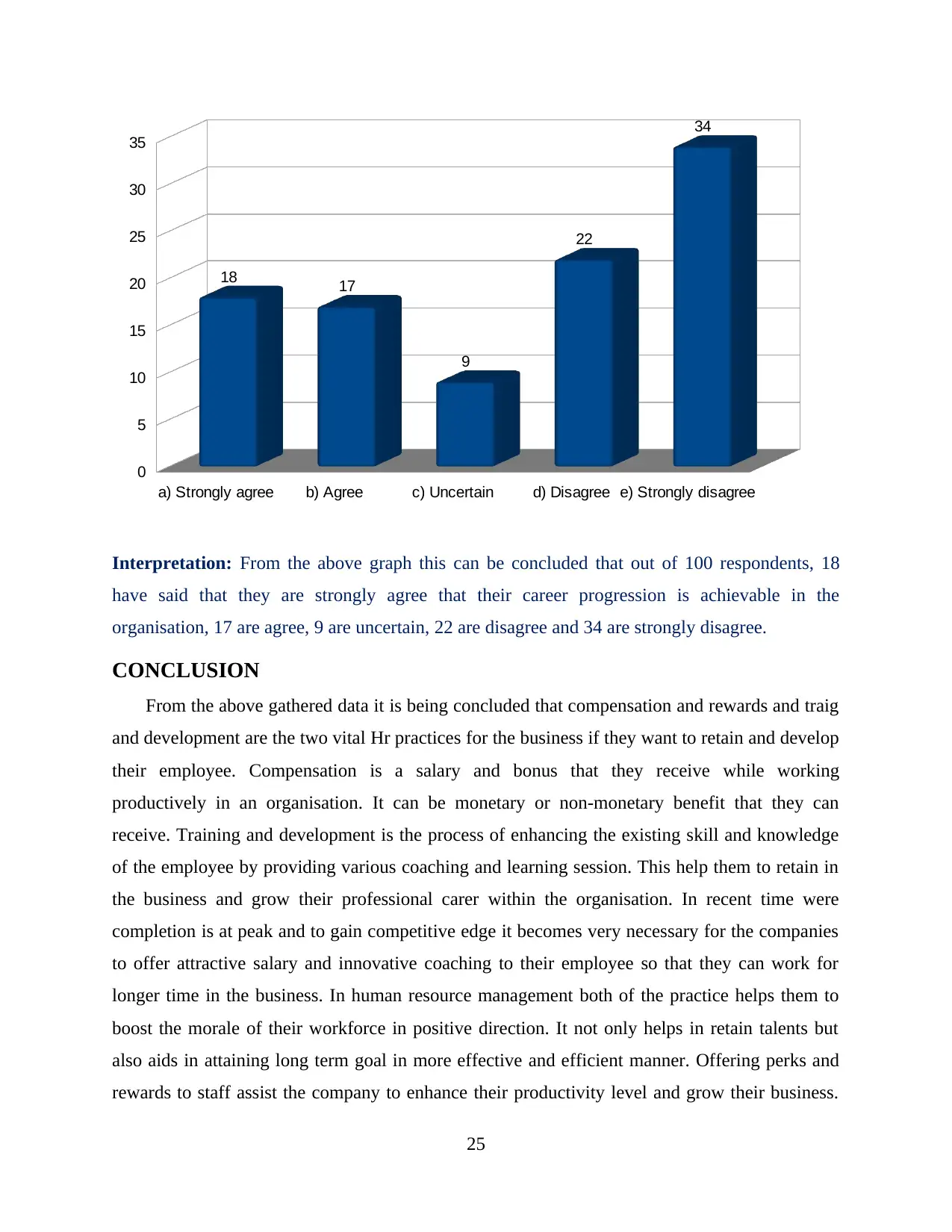
a) Strongly agree b) Agree c) Uncertain d) Disagree e) Strongly disagree
0
5
10
15
20
25
30
35
18 17
9
22
34
Interpretation: From the above graph this can be concluded that out of 100 respondents, 18
have said that they are strongly agree that their career progression is achievable in the
organisation, 17 are agree, 9 are uncertain, 22 are disagree and 34 are strongly disagree.
CONCLUSION
From the above gathered data it is being concluded that compensation and rewards and traig
and development are the two vital Hr practices for the business if they want to retain and develop
their employee. Compensation is a salary and bonus that they receive while working
productively in an organisation. It can be monetary or non-monetary benefit that they can
receive. Training and development is the process of enhancing the existing skill and knowledge
of the employee by providing various coaching and learning session. This help them to retain in
the business and grow their professional carer within the organisation. In recent time were
completion is at peak and to gain competitive edge it becomes very necessary for the companies
to offer attractive salary and innovative coaching to their employee so that they can work for
longer time in the business. In human resource management both of the practice helps them to
boost the morale of their workforce in positive direction. It not only helps in retain talents but
also aids in attaining long term goal in more effective and efficient manner. Offering perks and
rewards to staff assist the company to enhance their productivity level and grow their business.
25
0
5
10
15
20
25
30
35
18 17
9
22
34
Interpretation: From the above graph this can be concluded that out of 100 respondents, 18
have said that they are strongly agree that their career progression is achievable in the
organisation, 17 are agree, 9 are uncertain, 22 are disagree and 34 are strongly disagree.
CONCLUSION
From the above gathered data it is being concluded that compensation and rewards and traig
and development are the two vital Hr practices for the business if they want to retain and develop
their employee. Compensation is a salary and bonus that they receive while working
productively in an organisation. It can be monetary or non-monetary benefit that they can
receive. Training and development is the process of enhancing the existing skill and knowledge
of the employee by providing various coaching and learning session. This help them to retain in
the business and grow their professional carer within the organisation. In recent time were
completion is at peak and to gain competitive edge it becomes very necessary for the companies
to offer attractive salary and innovative coaching to their employee so that they can work for
longer time in the business. In human resource management both of the practice helps them to
boost the morale of their workforce in positive direction. It not only helps in retain talents but
also aids in attaining long term goal in more effective and efficient manner. Offering perks and
rewards to staff assist the company to enhance their productivity level and grow their business.
25
Paraphrase This Document
Need a fresh take? Get an instant paraphrase of this document with our AI Paraphraser
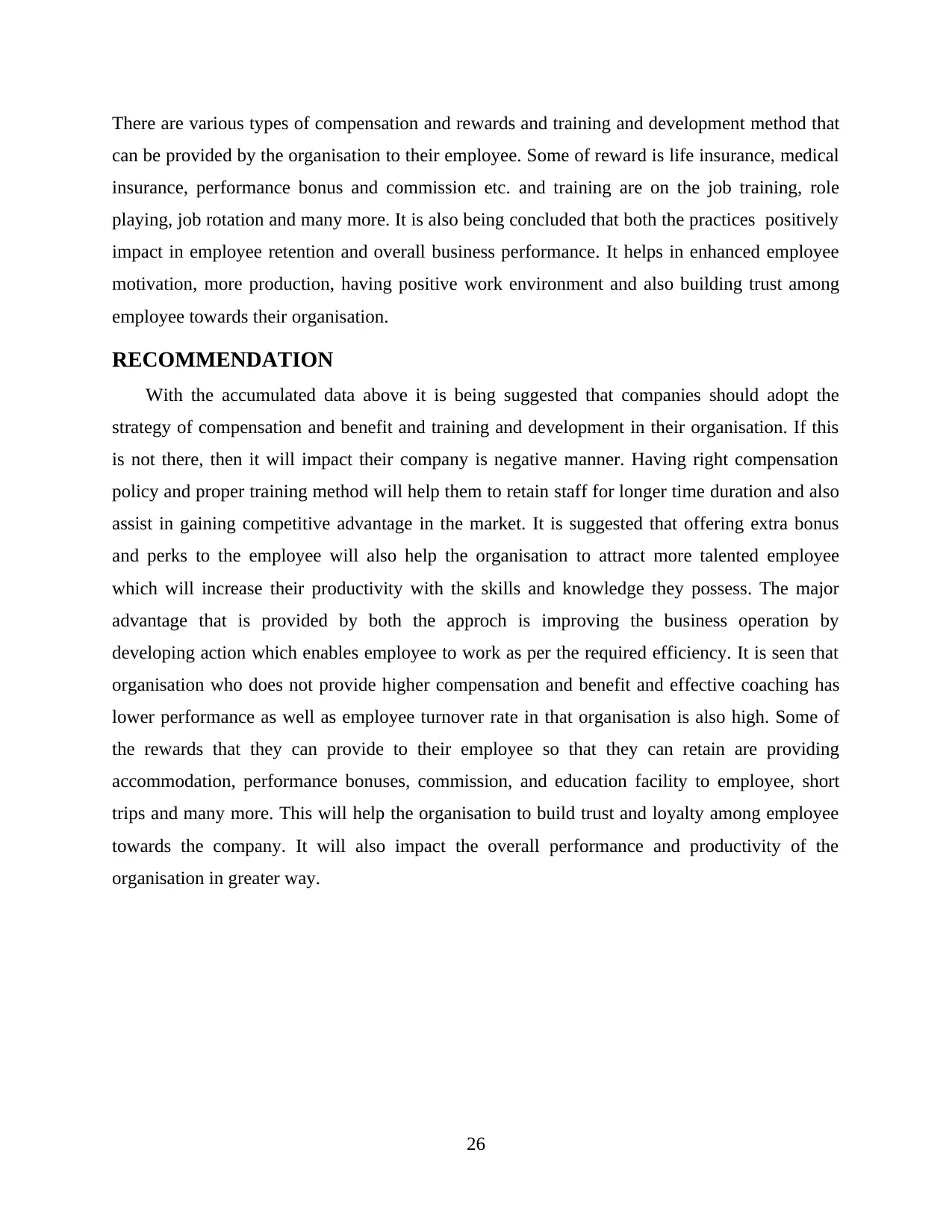
There are various types of compensation and rewards and training and development method that
can be provided by the organisation to their employee. Some of reward is life insurance, medical
insurance, performance bonus and commission etc. and training are on the job training, role
playing, job rotation and many more. It is also being concluded that both the practices positively
impact in employee retention and overall business performance. It helps in enhanced employee
motivation, more production, having positive work environment and also building trust among
employee towards their organisation.
RECOMMENDATION
With the accumulated data above it is being suggested that companies should adopt the
strategy of compensation and benefit and training and development in their organisation. If this
is not there, then it will impact their company is negative manner. Having right compensation
policy and proper training method will help them to retain staff for longer time duration and also
assist in gaining competitive advantage in the market. It is suggested that offering extra bonus
and perks to the employee will also help the organisation to attract more talented employee
which will increase their productivity with the skills and knowledge they possess. The major
advantage that is provided by both the approch is improving the business operation by
developing action which enables employee to work as per the required efficiency. It is seen that
organisation who does not provide higher compensation and benefit and effective coaching has
lower performance as well as employee turnover rate in that organisation is also high. Some of
the rewards that they can provide to their employee so that they can retain are providing
accommodation, performance bonuses, commission, and education facility to employee, short
trips and many more. This will help the organisation to build trust and loyalty among employee
towards the company. It will also impact the overall performance and productivity of the
organisation in greater way.
26
can be provided by the organisation to their employee. Some of reward is life insurance, medical
insurance, performance bonus and commission etc. and training are on the job training, role
playing, job rotation and many more. It is also being concluded that both the practices positively
impact in employee retention and overall business performance. It helps in enhanced employee
motivation, more production, having positive work environment and also building trust among
employee towards their organisation.
RECOMMENDATION
With the accumulated data above it is being suggested that companies should adopt the
strategy of compensation and benefit and training and development in their organisation. If this
is not there, then it will impact their company is negative manner. Having right compensation
policy and proper training method will help them to retain staff for longer time duration and also
assist in gaining competitive advantage in the market. It is suggested that offering extra bonus
and perks to the employee will also help the organisation to attract more talented employee
which will increase their productivity with the skills and knowledge they possess. The major
advantage that is provided by both the approch is improving the business operation by
developing action which enables employee to work as per the required efficiency. It is seen that
organisation who does not provide higher compensation and benefit and effective coaching has
lower performance as well as employee turnover rate in that organisation is also high. Some of
the rewards that they can provide to their employee so that they can retain are providing
accommodation, performance bonuses, commission, and education facility to employee, short
trips and many more. This will help the organisation to build trust and loyalty among employee
towards the company. It will also impact the overall performance and productivity of the
organisation in greater way.
26
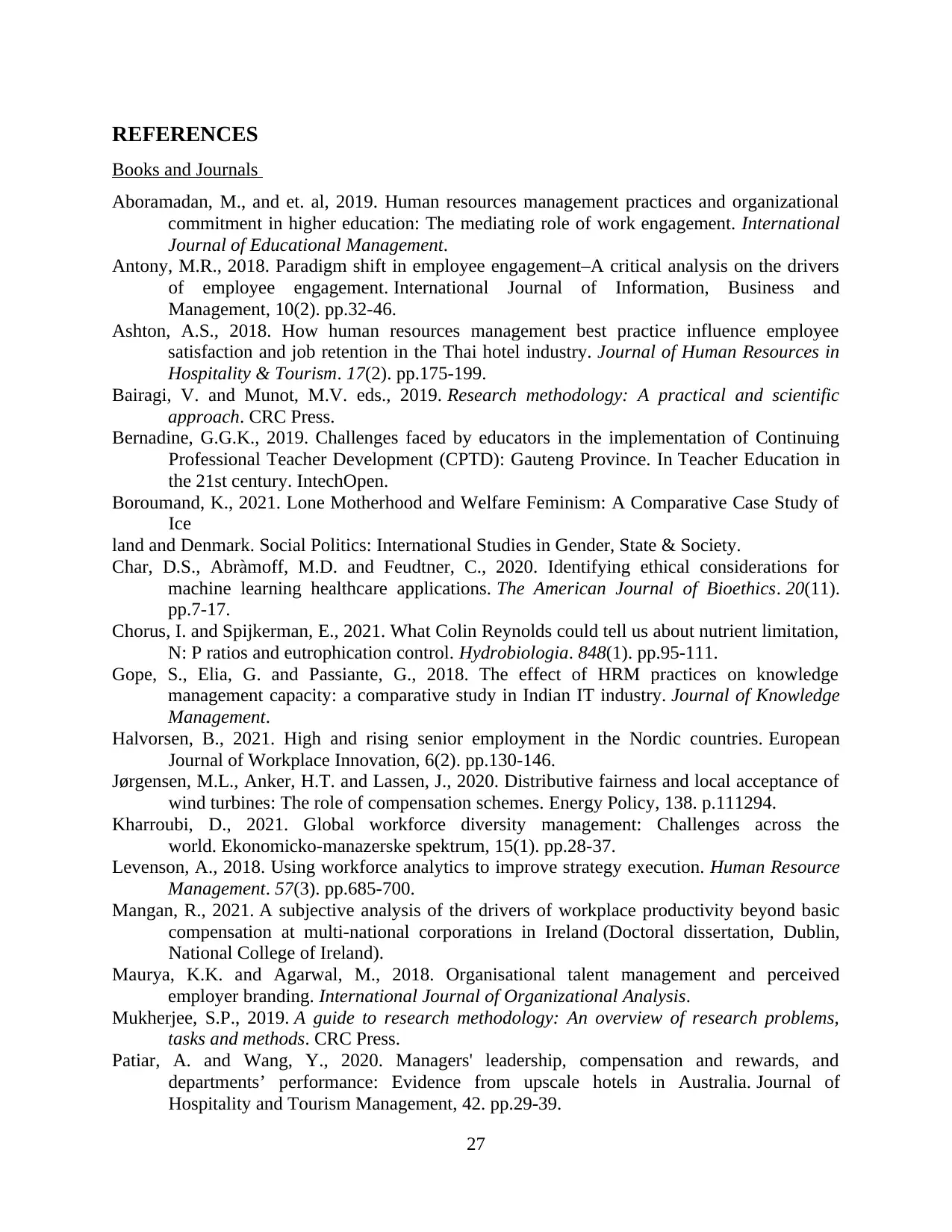
REFERENCES
Books and Journals
Aboramadan, M., and et. al, 2019. Human resources management practices and organizational
commitment in higher education: The mediating role of work engagement. International
Journal of Educational Management.
Antony, M.R., 2018. Paradigm shift in employee engagement–A critical analysis on the drivers
of employee engagement. International Journal of Information, Business and
Management, 10(2). pp.32-46.
Ashton, A.S., 2018. How human resources management best practice influence employee
satisfaction and job retention in the Thai hotel industry. Journal of Human Resources in
Hospitality & Tourism. 17(2). pp.175-199.
Bairagi, V. and Munot, M.V. eds., 2019. Research methodology: A practical and scientific
approach. CRC Press.
Bernadine, G.G.K., 2019. Challenges faced by educators in the implementation of Continuing
Professional Teacher Development (CPTD): Gauteng Province. In Teacher Education in
the 21st century. IntechOpen.
Boroumand, K., 2021. Lone Motherhood and Welfare Feminism: A Comparative Case Study of
Ice
land and Denmark. Social Politics: International Studies in Gender, State & Society.
Char, D.S., Abràmoff, M.D. and Feudtner, C., 2020. Identifying ethical considerations for
machine learning healthcare applications. The American Journal of Bioethics. 20(11).
pp.7-17.
Chorus, I. and Spijkerman, E., 2021. What Colin Reynolds could tell us about nutrient limitation,
N: P ratios and eutrophication control. Hydrobiologia. 848(1). pp.95-111.
Gope, S., Elia, G. and Passiante, G., 2018. The effect of HRM practices on knowledge
management capacity: a comparative study in Indian IT industry. Journal of Knowledge
Management.
Halvorsen, B., 2021. High and rising senior employment in the Nordic countries. European
Journal of Workplace Innovation, 6(2). pp.130-146.
Jørgensen, M.L., Anker, H.T. and Lassen, J., 2020. Distributive fairness and local acceptance of
wind turbines: The role of compensation schemes. Energy Policy, 138. p.111294.
Kharroubi, D., 2021. Global workforce diversity management: Challenges across the
world. Ekonomicko-manazerske spektrum, 15(1). pp.28-37.
Levenson, A., 2018. Using workforce analytics to improve strategy execution. Human Resource
Management. 57(3). pp.685-700.
Mangan, R., 2021. A subjective analysis of the drivers of workplace productivity beyond basic
compensation at multi-national corporations in Ireland (Doctoral dissertation, Dublin,
National College of Ireland).
Maurya, K.K. and Agarwal, M., 2018. Organisational talent management and perceived
employer branding. International Journal of Organizational Analysis.
Mukherjee, S.P., 2019. A guide to research methodology: An overview of research problems,
tasks and methods. CRC Press.
Patiar, A. and Wang, Y., 2020. Managers' leadership, compensation and rewards, and
departments’ performance: Evidence from upscale hotels in Australia. Journal of
Hospitality and Tourism Management, 42. pp.29-39.
27
Books and Journals
Aboramadan, M., and et. al, 2019. Human resources management practices and organizational
commitment in higher education: The mediating role of work engagement. International
Journal of Educational Management.
Antony, M.R., 2018. Paradigm shift in employee engagement–A critical analysis on the drivers
of employee engagement. International Journal of Information, Business and
Management, 10(2). pp.32-46.
Ashton, A.S., 2018. How human resources management best practice influence employee
satisfaction and job retention in the Thai hotel industry. Journal of Human Resources in
Hospitality & Tourism. 17(2). pp.175-199.
Bairagi, V. and Munot, M.V. eds., 2019. Research methodology: A practical and scientific
approach. CRC Press.
Bernadine, G.G.K., 2019. Challenges faced by educators in the implementation of Continuing
Professional Teacher Development (CPTD): Gauteng Province. In Teacher Education in
the 21st century. IntechOpen.
Boroumand, K., 2021. Lone Motherhood and Welfare Feminism: A Comparative Case Study of
Ice
land and Denmark. Social Politics: International Studies in Gender, State & Society.
Char, D.S., Abràmoff, M.D. and Feudtner, C., 2020. Identifying ethical considerations for
machine learning healthcare applications. The American Journal of Bioethics. 20(11).
pp.7-17.
Chorus, I. and Spijkerman, E., 2021. What Colin Reynolds could tell us about nutrient limitation,
N: P ratios and eutrophication control. Hydrobiologia. 848(1). pp.95-111.
Gope, S., Elia, G. and Passiante, G., 2018. The effect of HRM practices on knowledge
management capacity: a comparative study in Indian IT industry. Journal of Knowledge
Management.
Halvorsen, B., 2021. High and rising senior employment in the Nordic countries. European
Journal of Workplace Innovation, 6(2). pp.130-146.
Jørgensen, M.L., Anker, H.T. and Lassen, J., 2020. Distributive fairness and local acceptance of
wind turbines: The role of compensation schemes. Energy Policy, 138. p.111294.
Kharroubi, D., 2021. Global workforce diversity management: Challenges across the
world. Ekonomicko-manazerske spektrum, 15(1). pp.28-37.
Levenson, A., 2018. Using workforce analytics to improve strategy execution. Human Resource
Management. 57(3). pp.685-700.
Mangan, R., 2021. A subjective analysis of the drivers of workplace productivity beyond basic
compensation at multi-national corporations in Ireland (Doctoral dissertation, Dublin,
National College of Ireland).
Maurya, K.K. and Agarwal, M., 2018. Organisational talent management and perceived
employer branding. International Journal of Organizational Analysis.
Mukherjee, S.P., 2019. A guide to research methodology: An overview of research problems,
tasks and methods. CRC Press.
Patiar, A. and Wang, Y., 2020. Managers' leadership, compensation and rewards, and
departments’ performance: Evidence from upscale hotels in Australia. Journal of
Hospitality and Tourism Management, 42. pp.29-39.
27
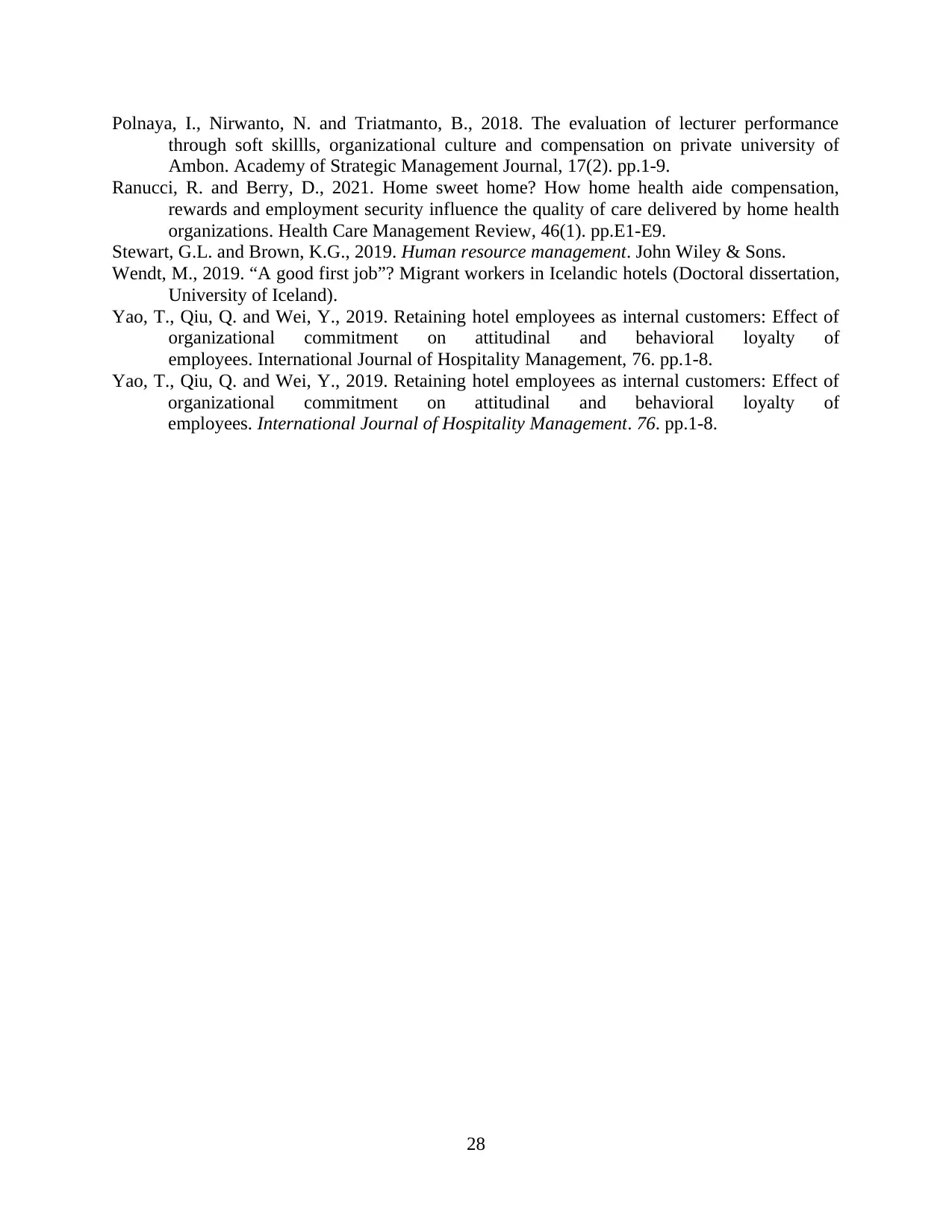
Polnaya, I., Nirwanto, N. and Triatmanto, B., 2018. The evaluation of lecturer performance
through soft skillls, organizational culture and compensation on private university of
Ambon. Academy of Strategic Management Journal, 17(2). pp.1-9.
Ranucci, R. and Berry, D., 2021. Home sweet home? How home health aide compensation,
rewards and employment security influence the quality of care delivered by home health
organizations. Health Care Management Review, 46(1). pp.E1-E9.
Stewart, G.L. and Brown, K.G., 2019. Human resource management. John Wiley & Sons.
Wendt, M., 2019. “A good first job”? Migrant workers in Icelandic hotels (Doctoral dissertation,
University of Iceland).
Yao, T., Qiu, Q. and Wei, Y., 2019. Retaining hotel employees as internal customers: Effect of
organizational commitment on attitudinal and behavioral loyalty of
employees. International Journal of Hospitality Management, 76. pp.1-8.
Yao, T., Qiu, Q. and Wei, Y., 2019. Retaining hotel employees as internal customers: Effect of
organizational commitment on attitudinal and behavioral loyalty of
employees. International Journal of Hospitality Management. 76. pp.1-8.
28
through soft skillls, organizational culture and compensation on private university of
Ambon. Academy of Strategic Management Journal, 17(2). pp.1-9.
Ranucci, R. and Berry, D., 2021. Home sweet home? How home health aide compensation,
rewards and employment security influence the quality of care delivered by home health
organizations. Health Care Management Review, 46(1). pp.E1-E9.
Stewart, G.L. and Brown, K.G., 2019. Human resource management. John Wiley & Sons.
Wendt, M., 2019. “A good first job”? Migrant workers in Icelandic hotels (Doctoral dissertation,
University of Iceland).
Yao, T., Qiu, Q. and Wei, Y., 2019. Retaining hotel employees as internal customers: Effect of
organizational commitment on attitudinal and behavioral loyalty of
employees. International Journal of Hospitality Management, 76. pp.1-8.
Yao, T., Qiu, Q. and Wei, Y., 2019. Retaining hotel employees as internal customers: Effect of
organizational commitment on attitudinal and behavioral loyalty of
employees. International Journal of Hospitality Management. 76. pp.1-8.
28
Secure Best Marks with AI Grader
Need help grading? Try our AI Grader for instant feedback on your assignments.
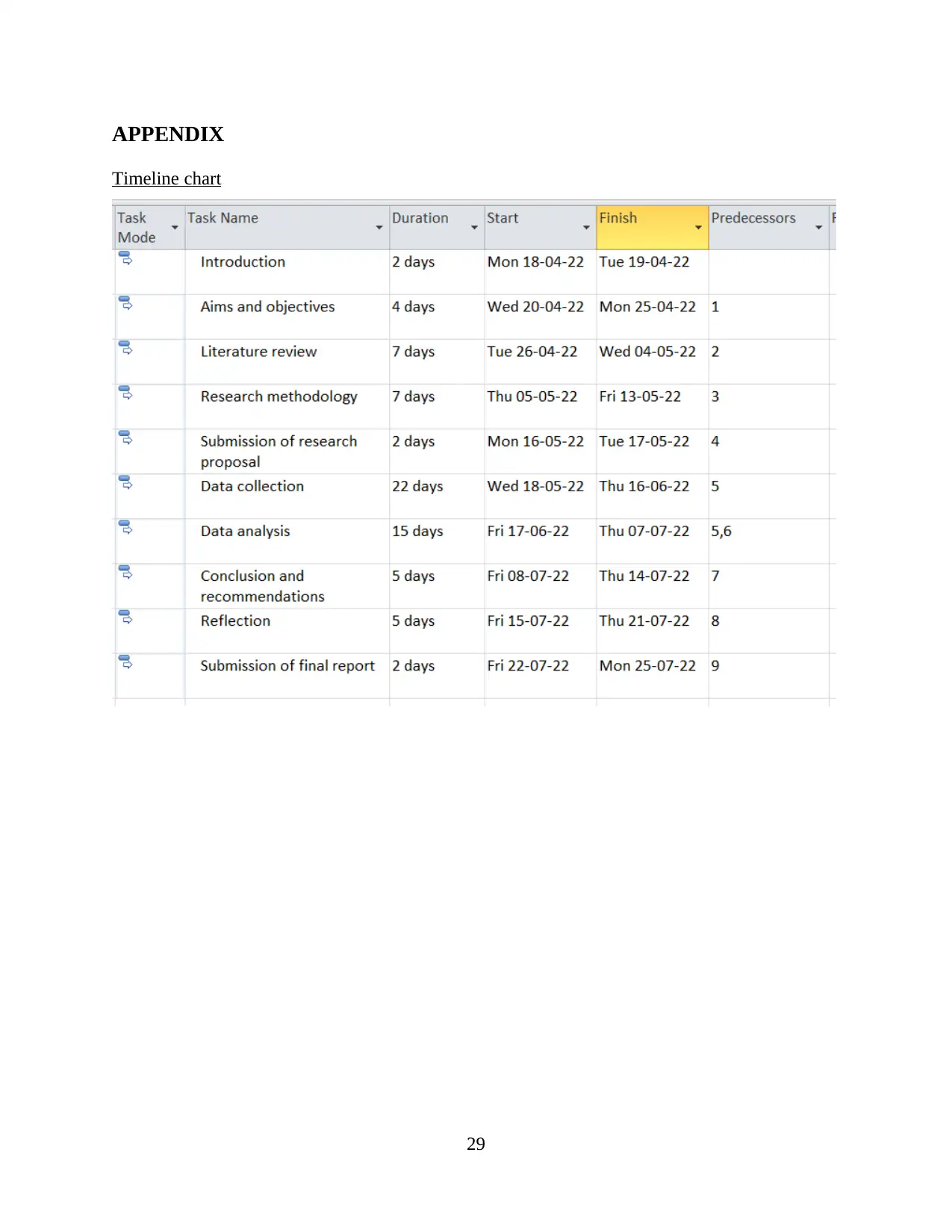
APPENDIX
Timeline chart
29
Timeline chart
29
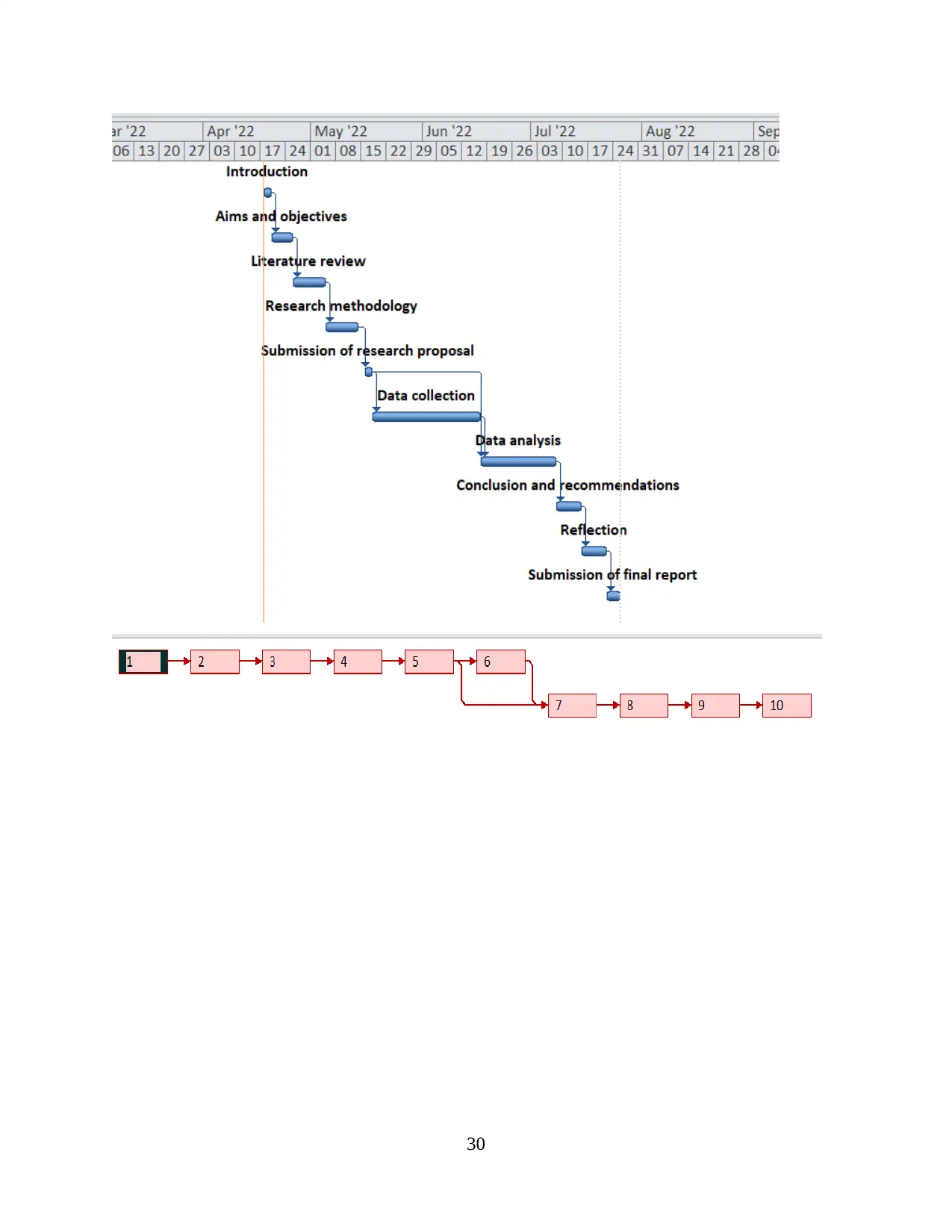
30
1 out of 30
Related Documents
Your All-in-One AI-Powered Toolkit for Academic Success.
+13062052269
info@desklib.com
Available 24*7 on WhatsApp / Email
![[object Object]](/_next/static/media/star-bottom.7253800d.svg)
Unlock your academic potential
© 2024 | Zucol Services PVT LTD | All rights reserved.





